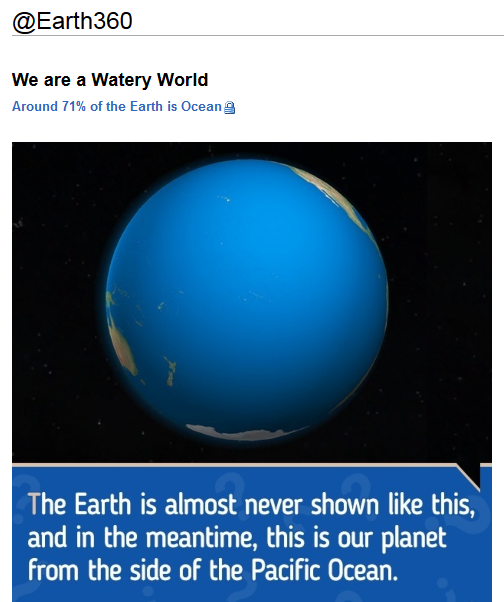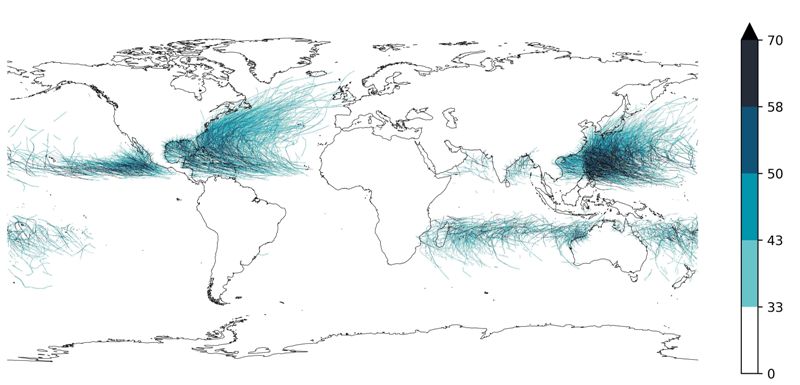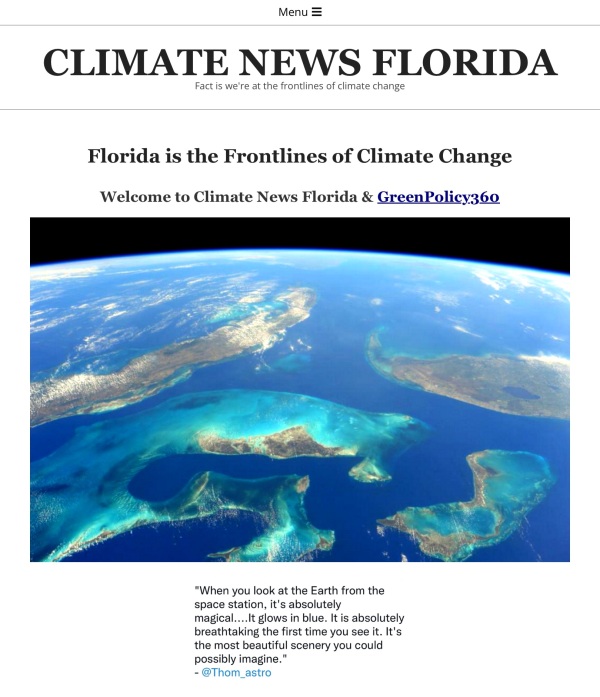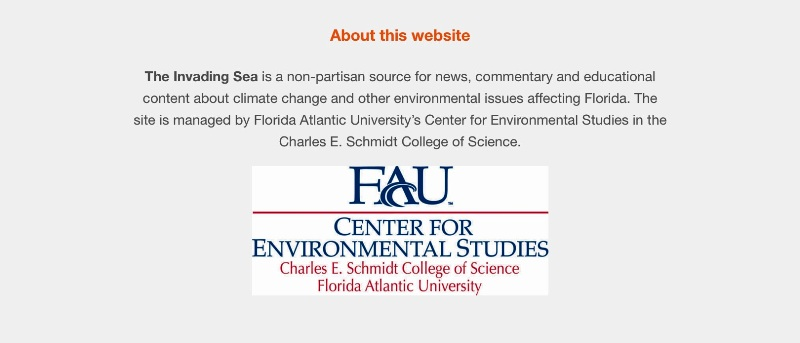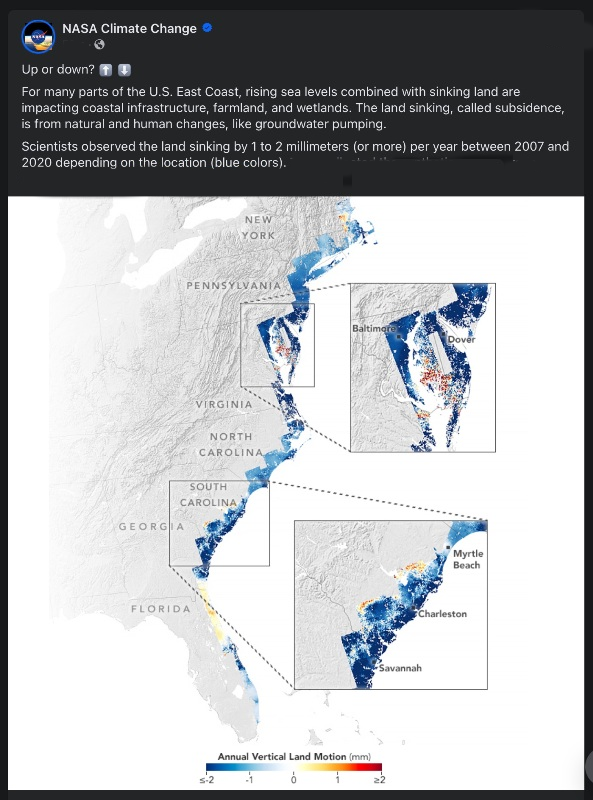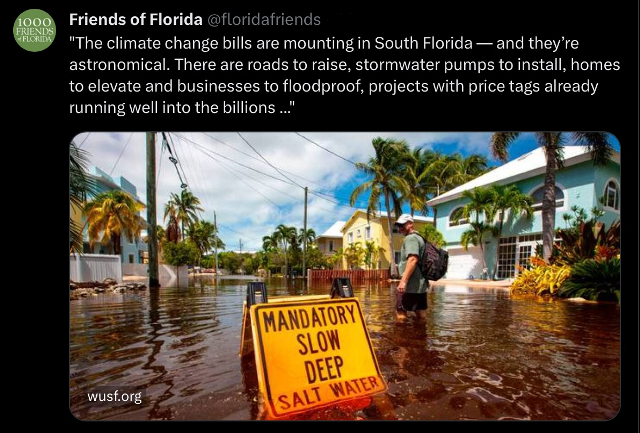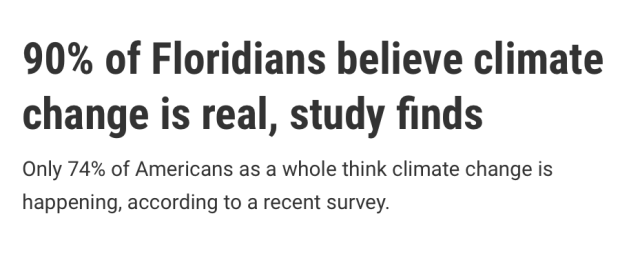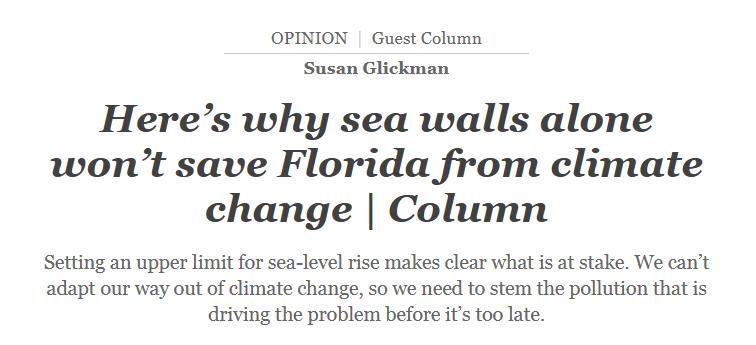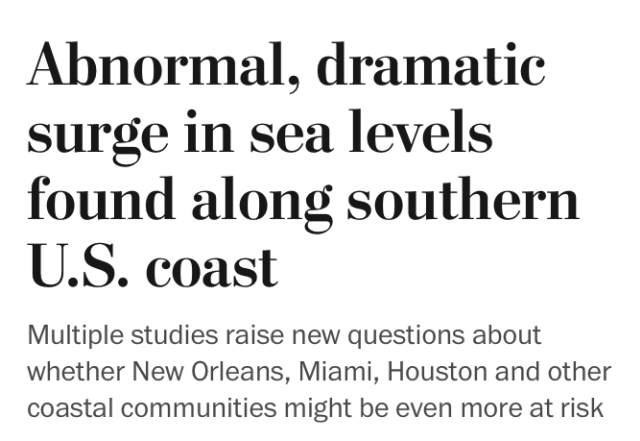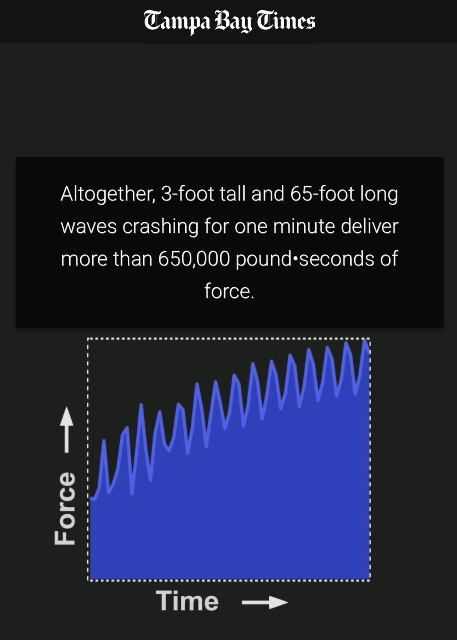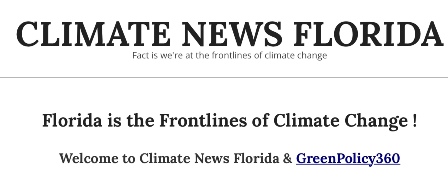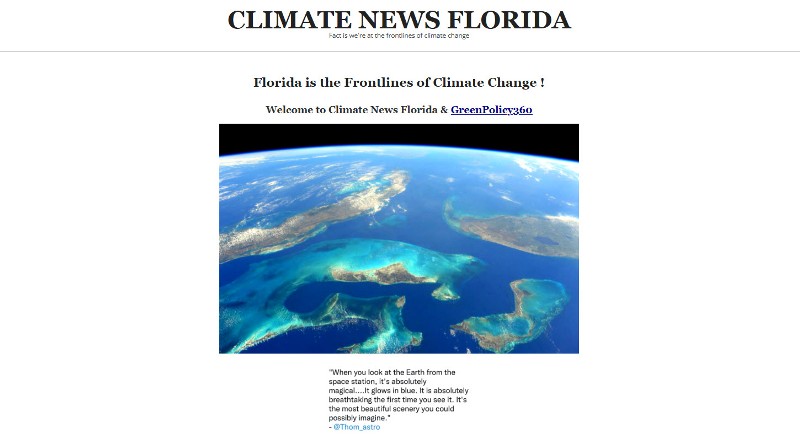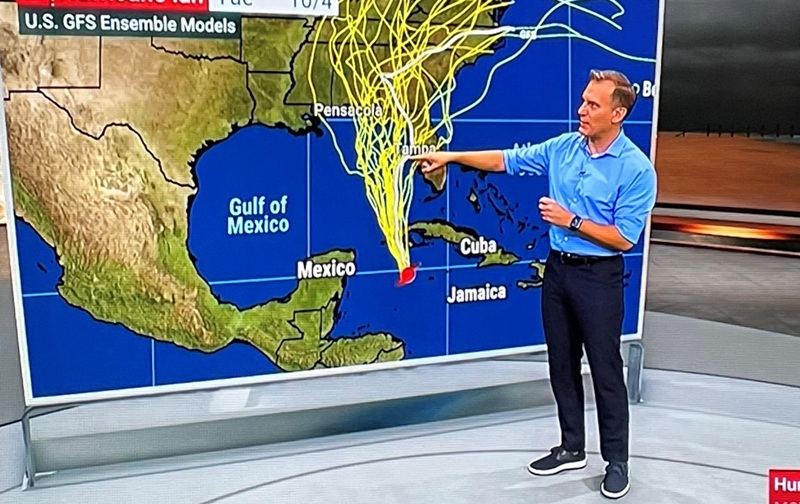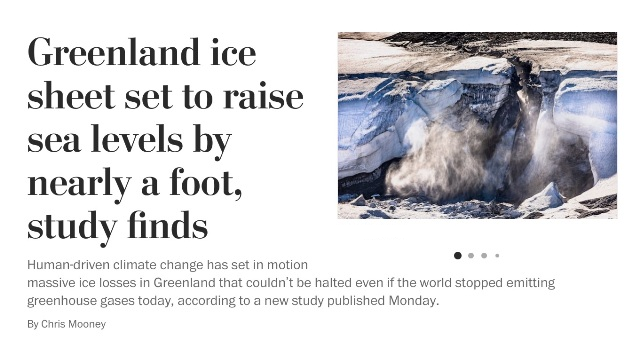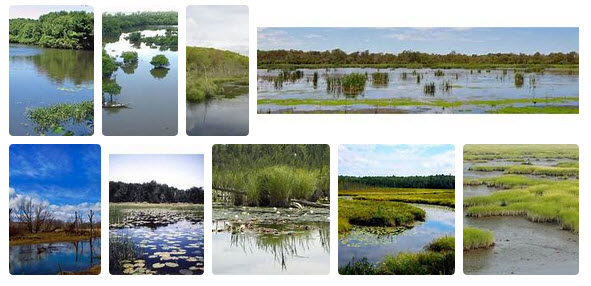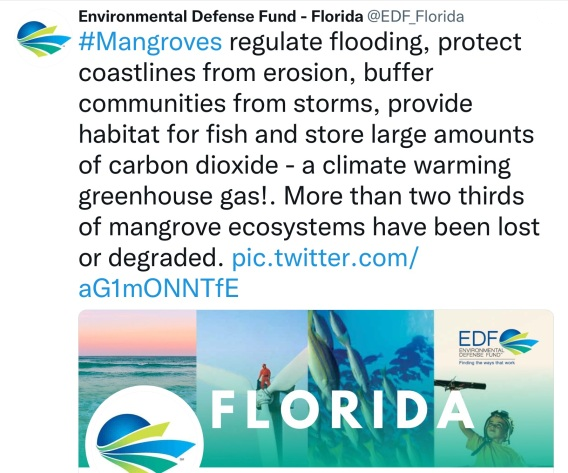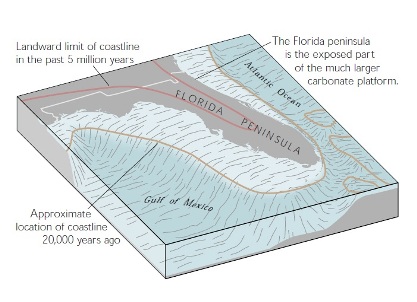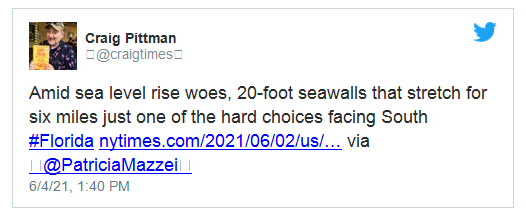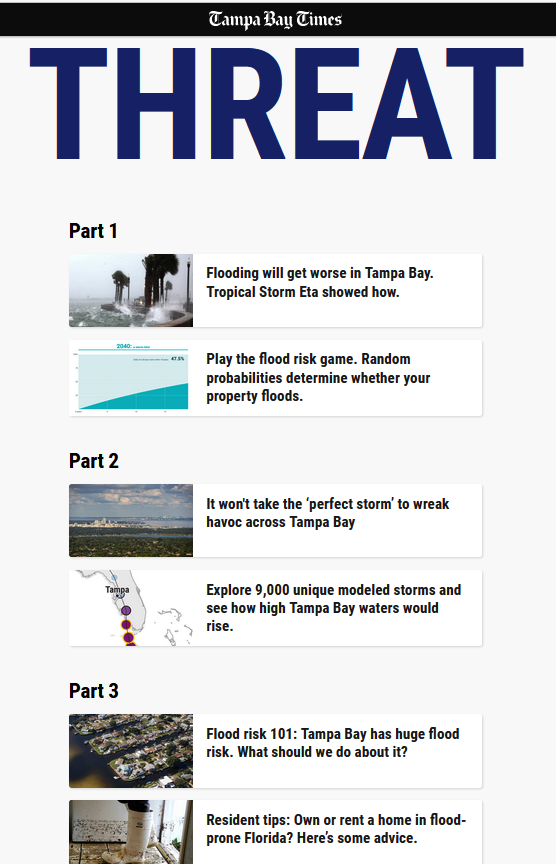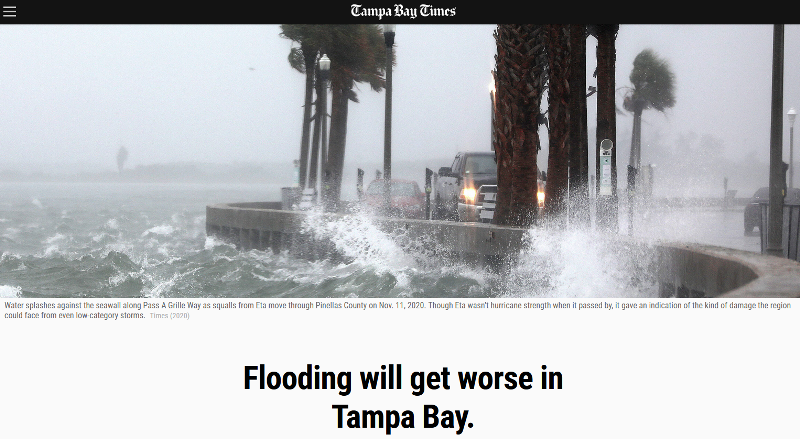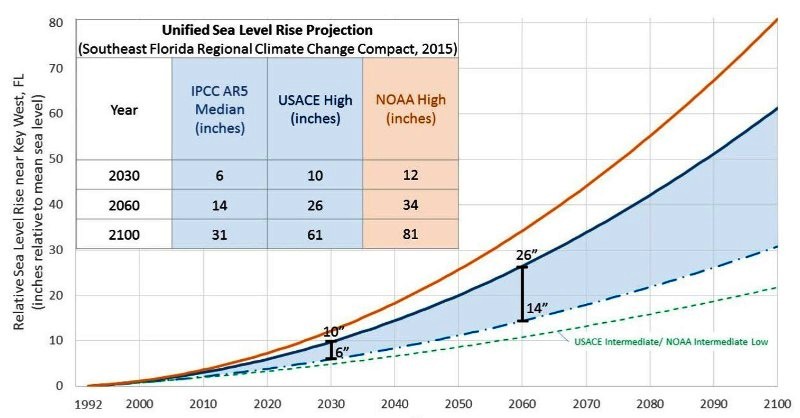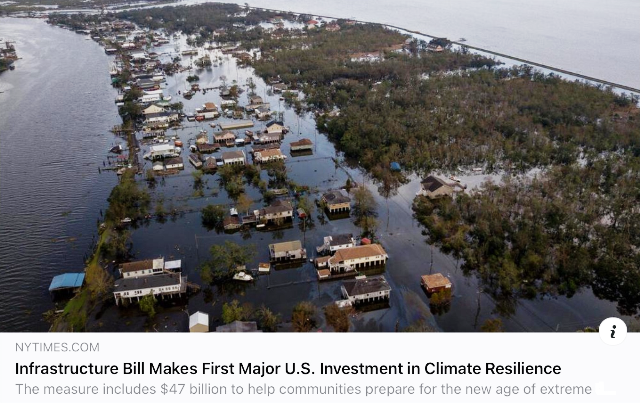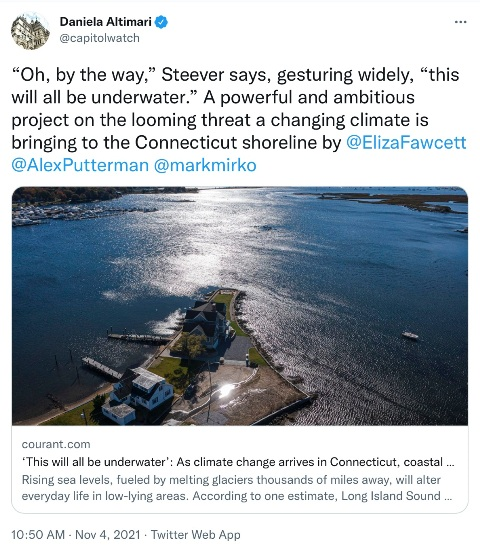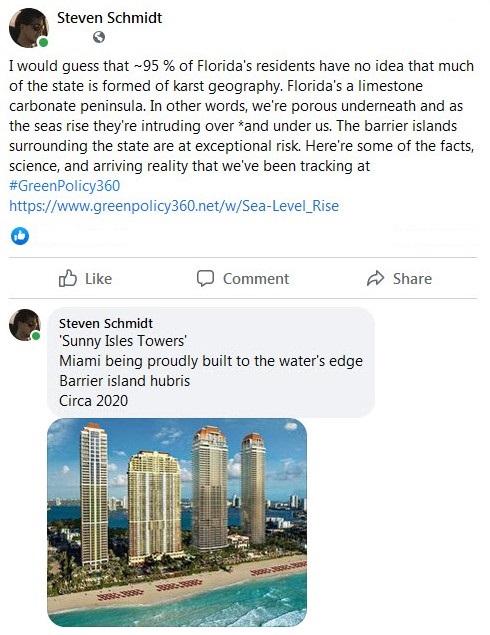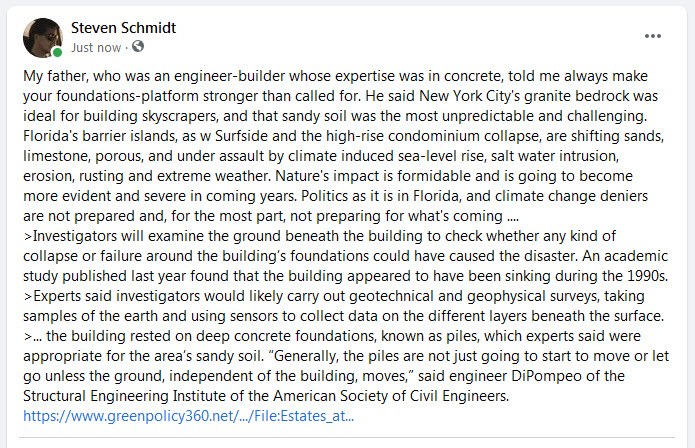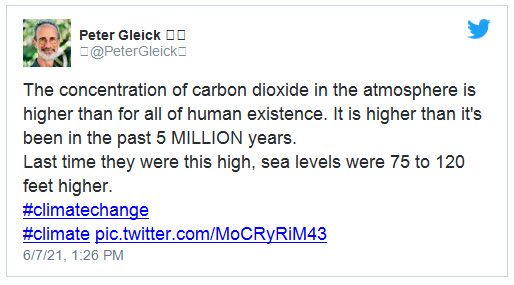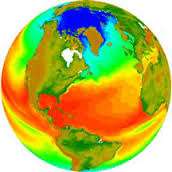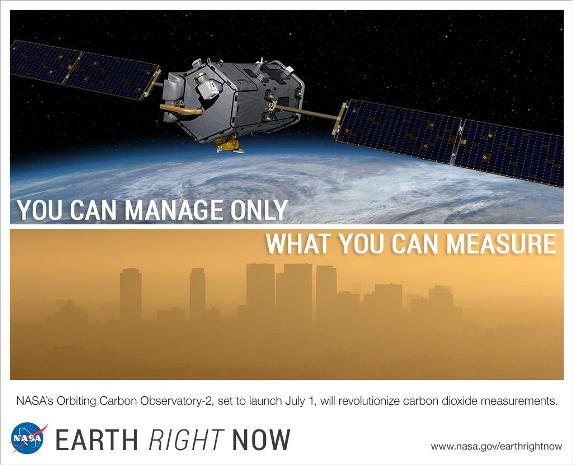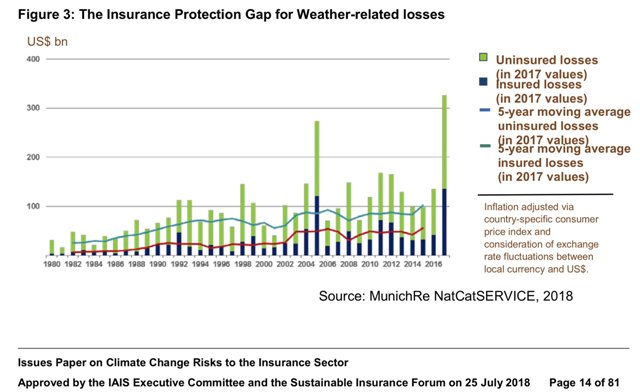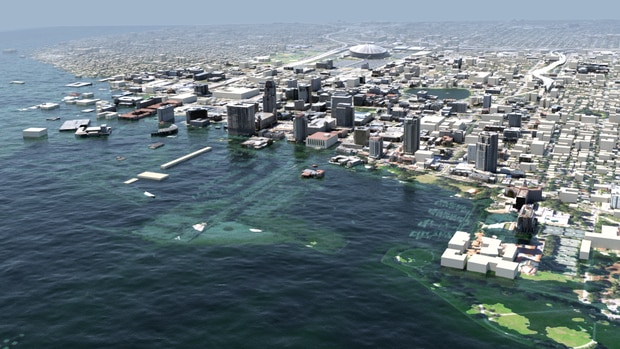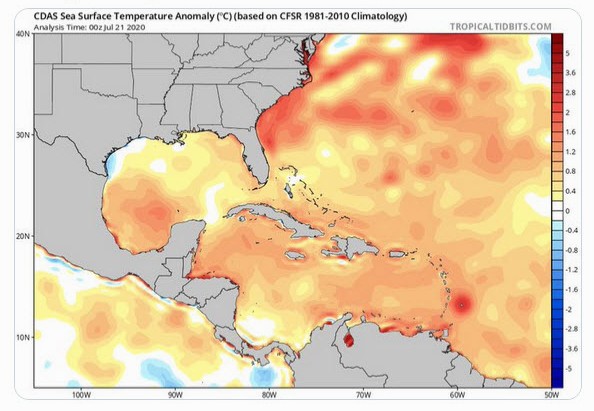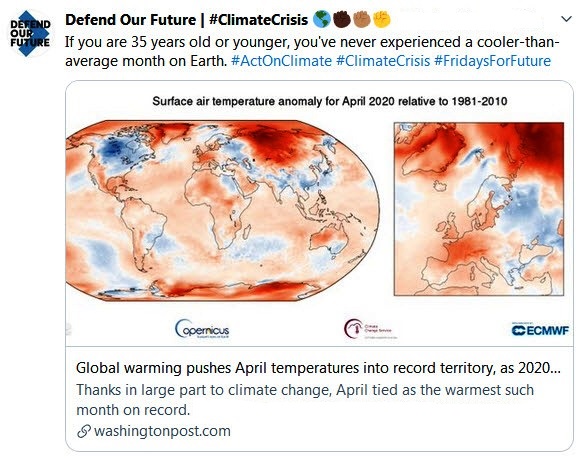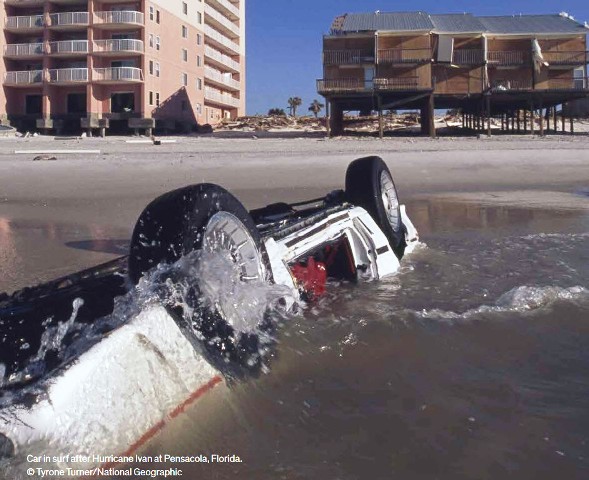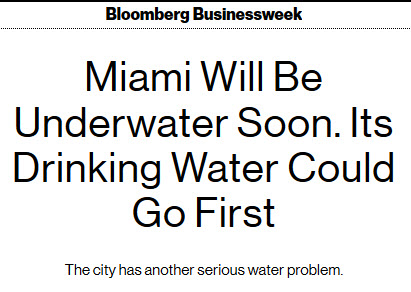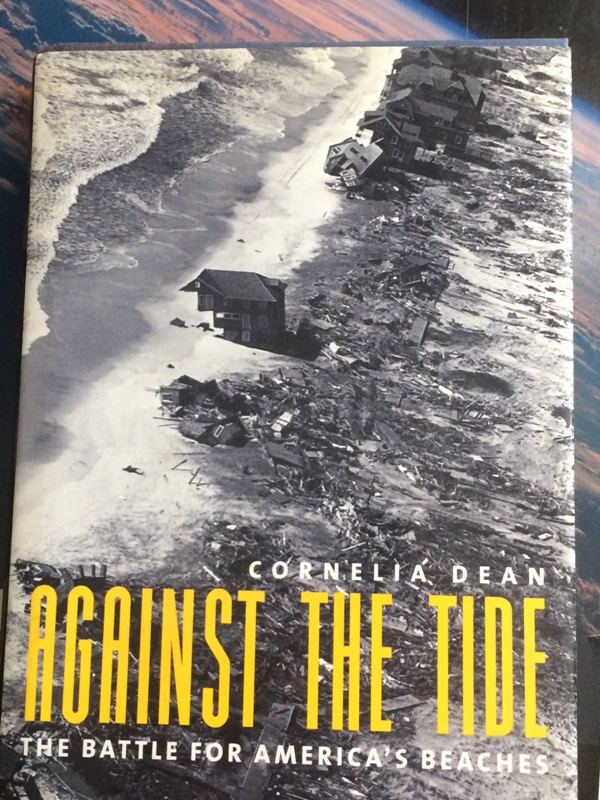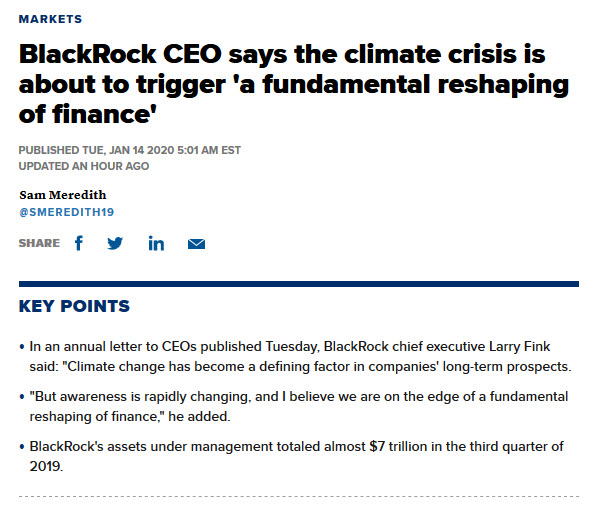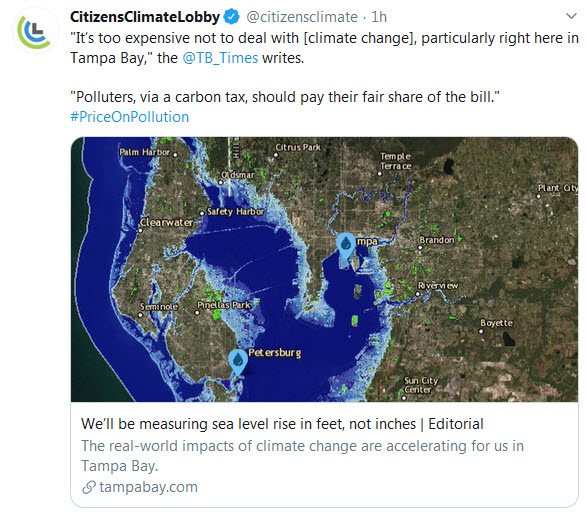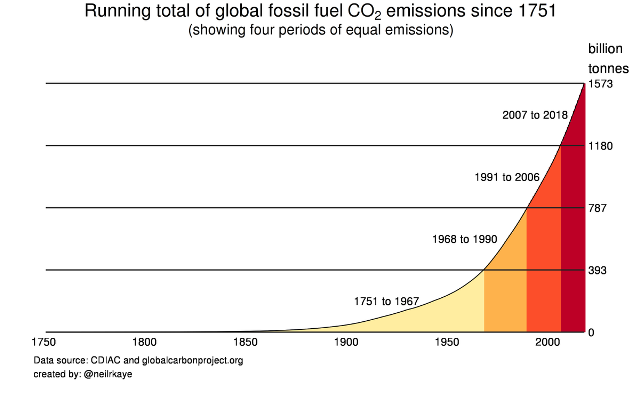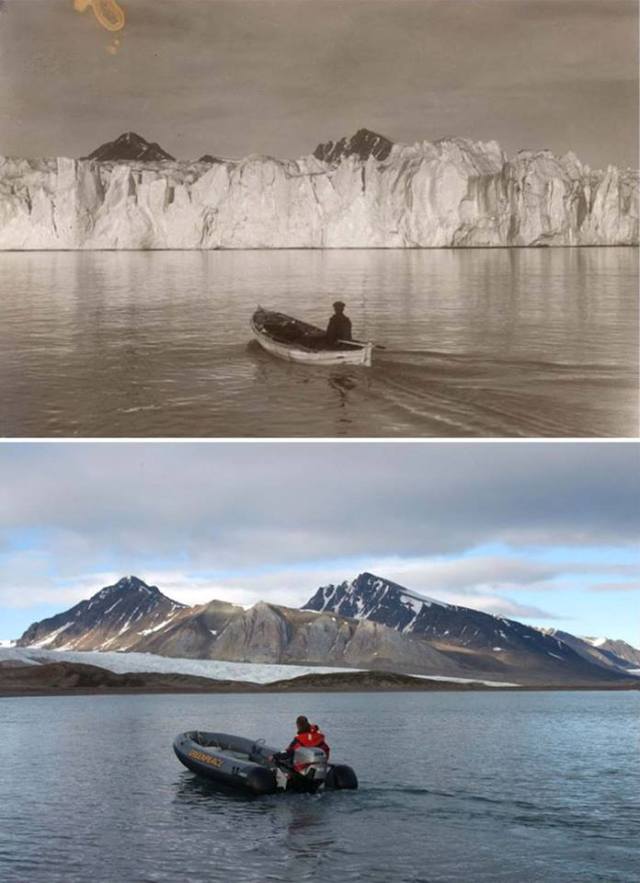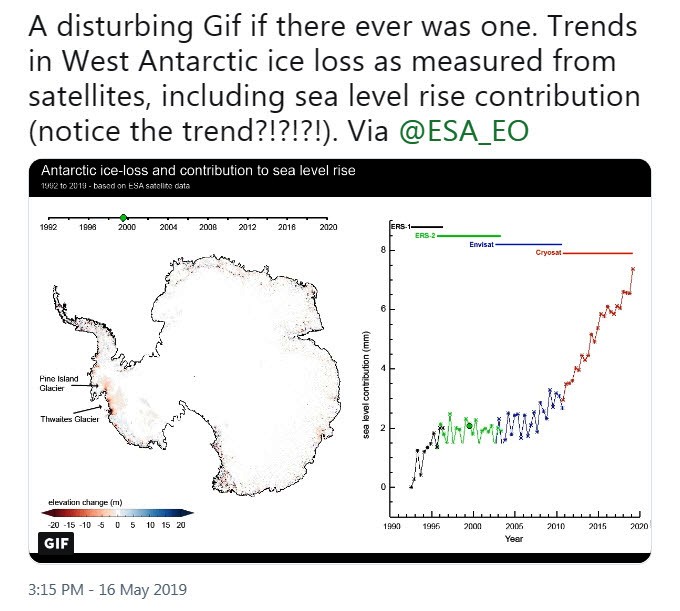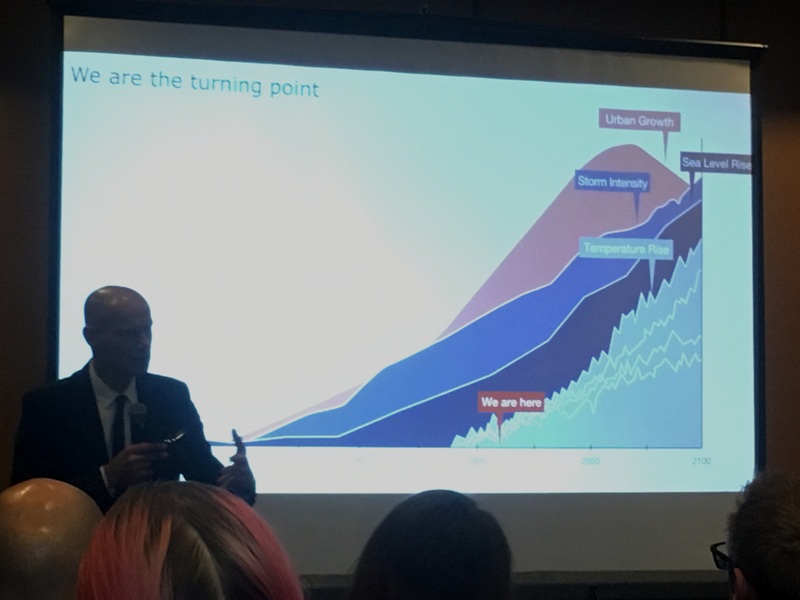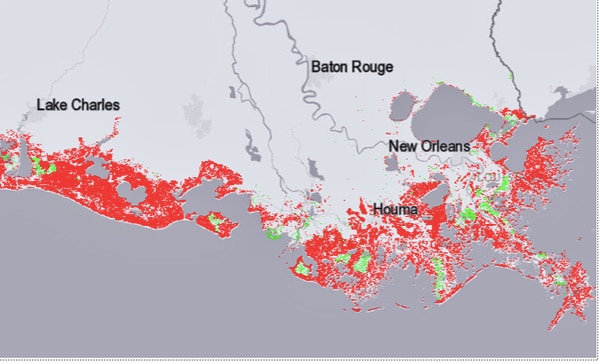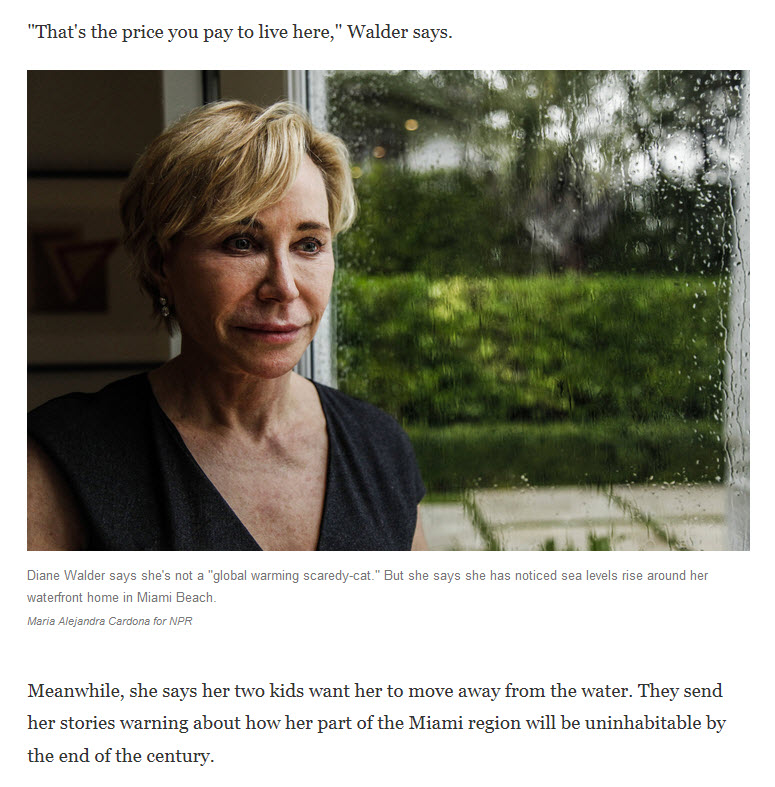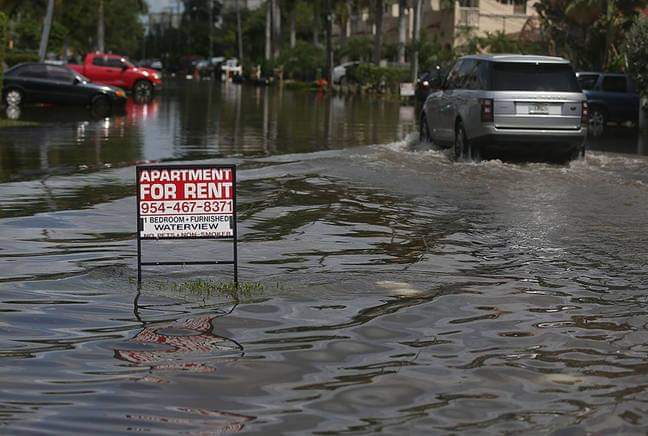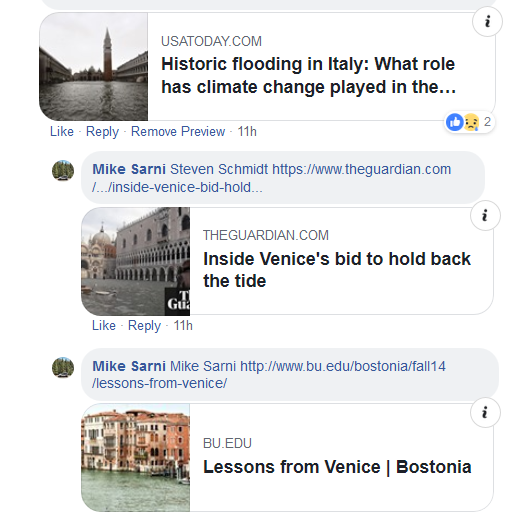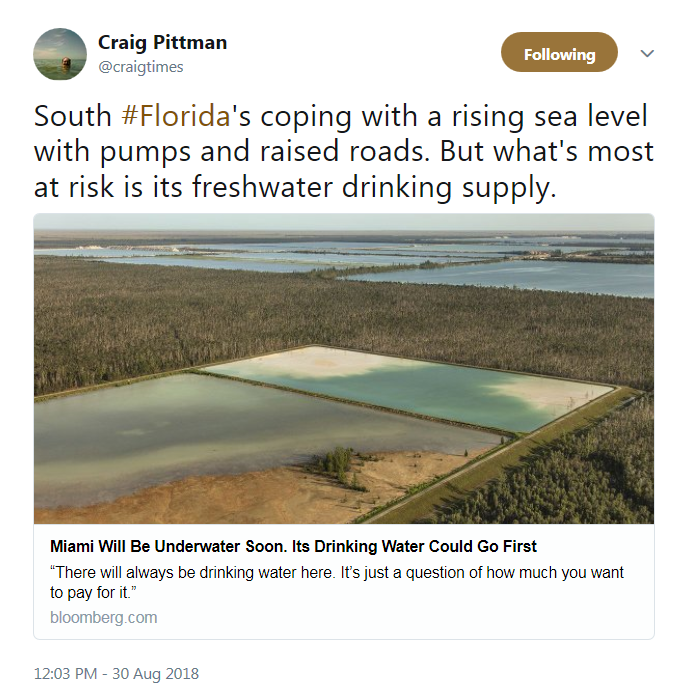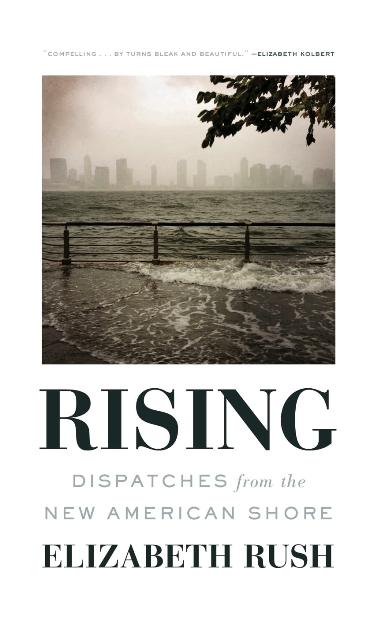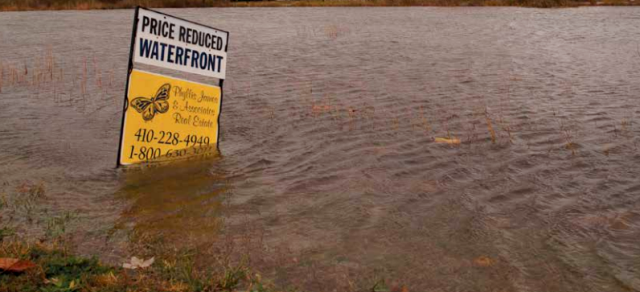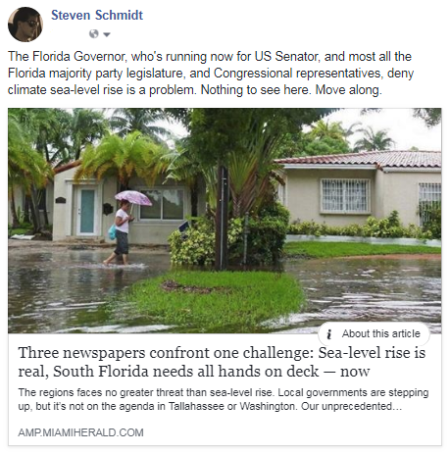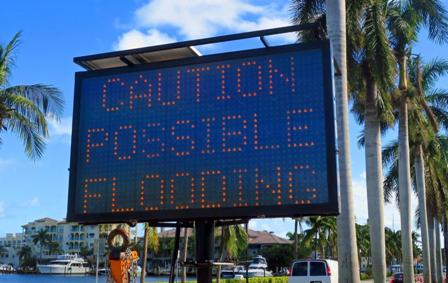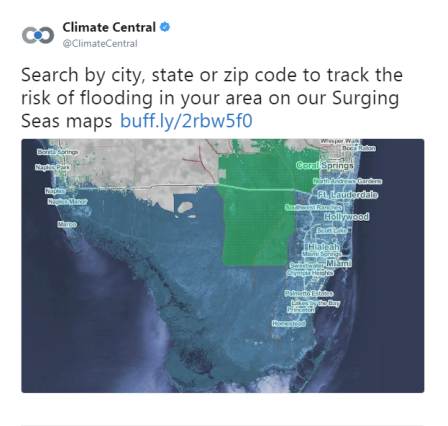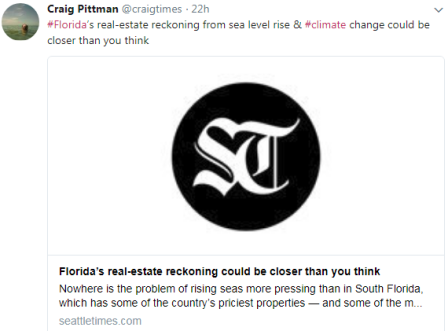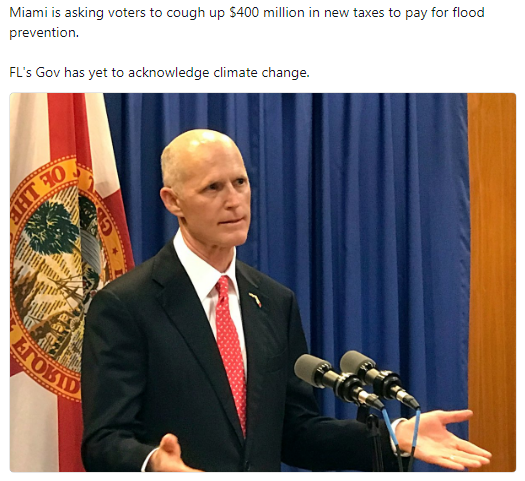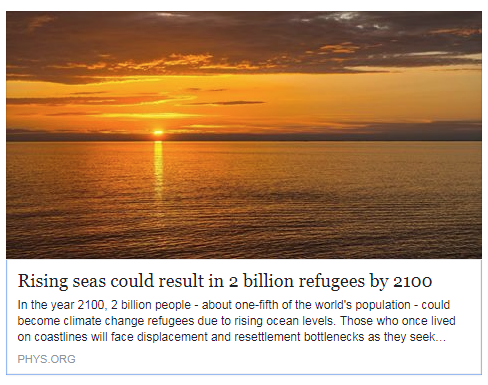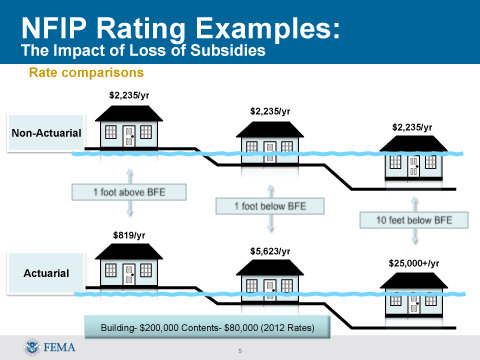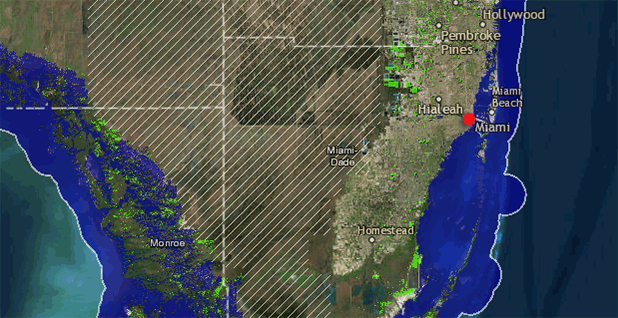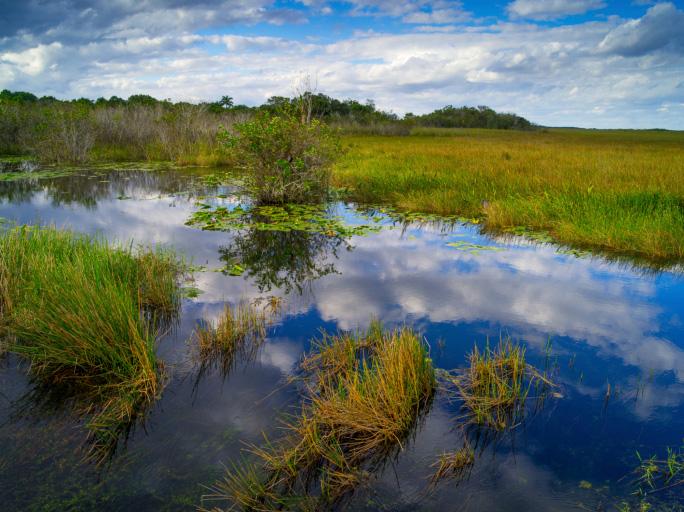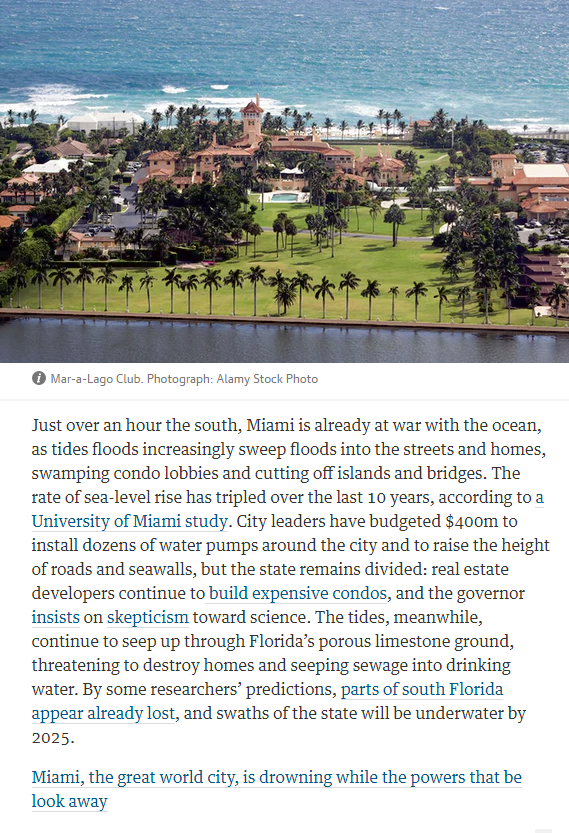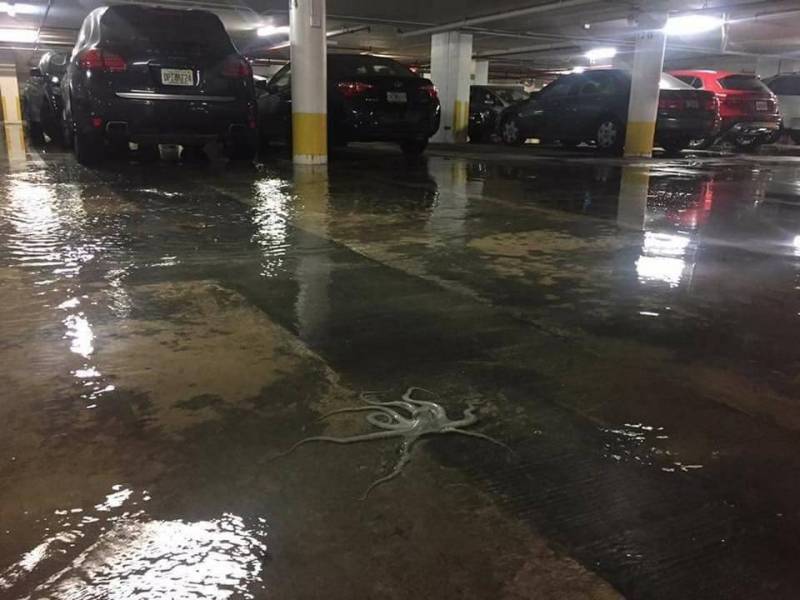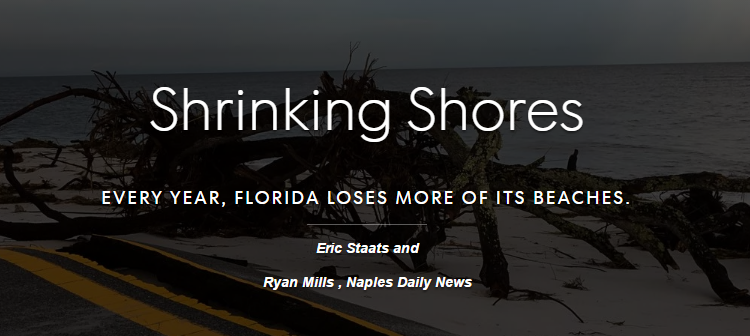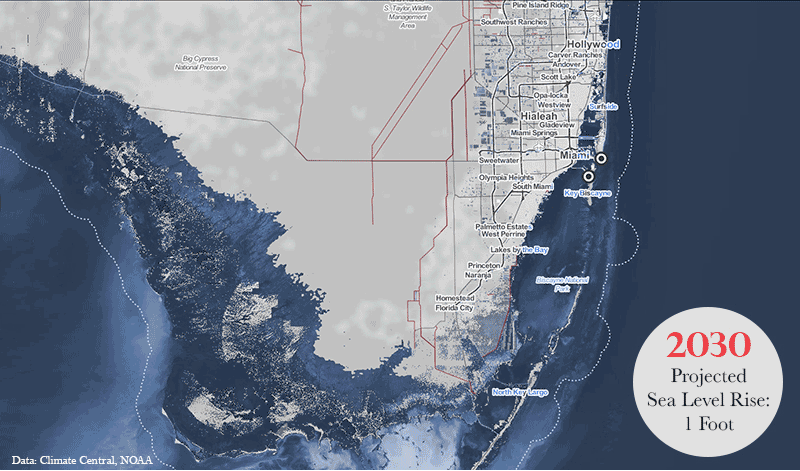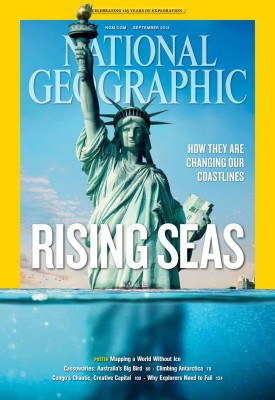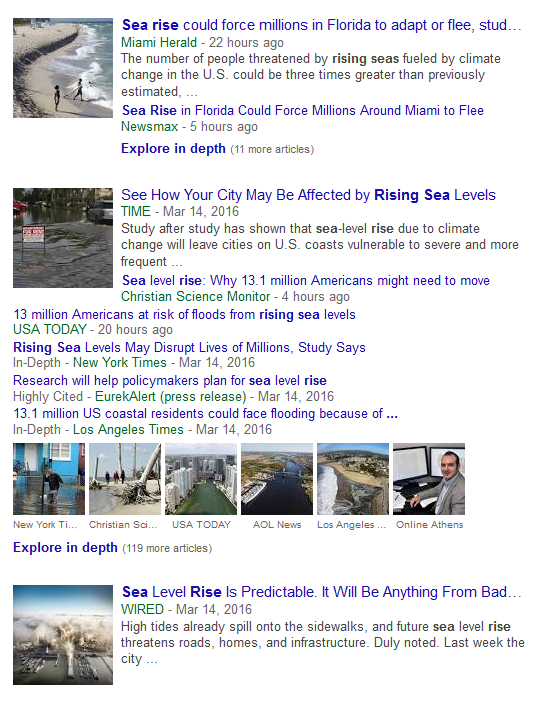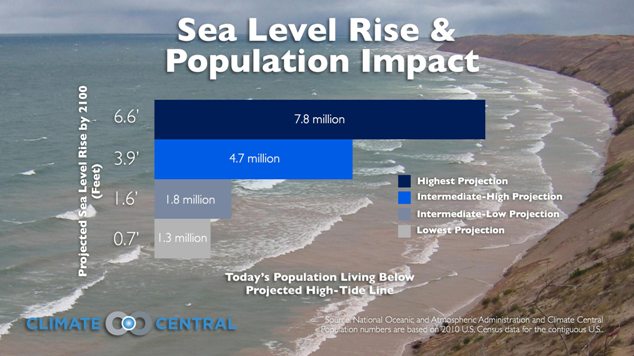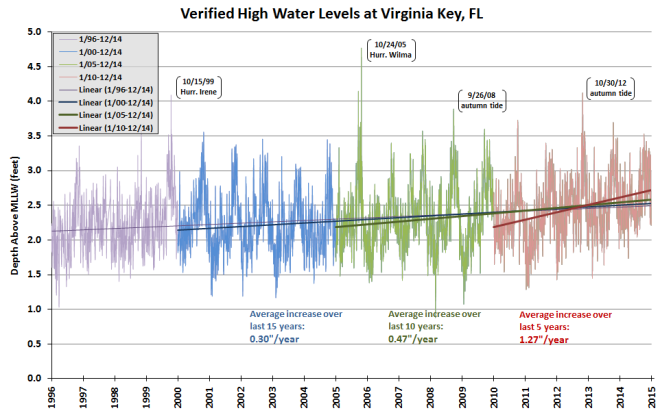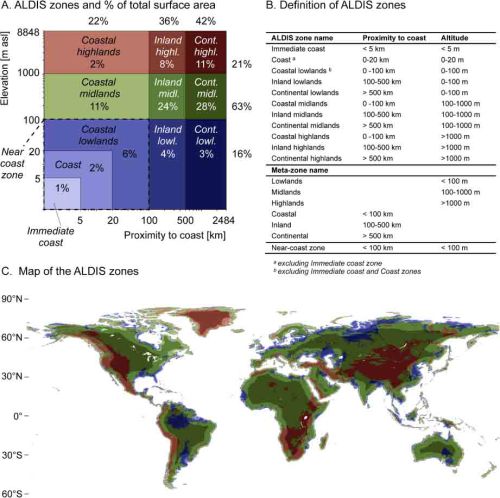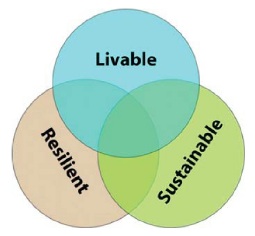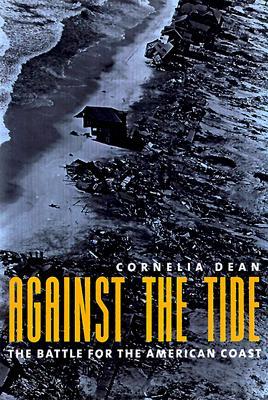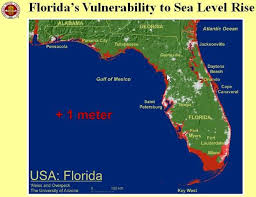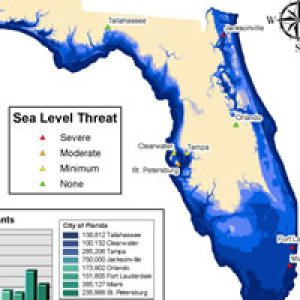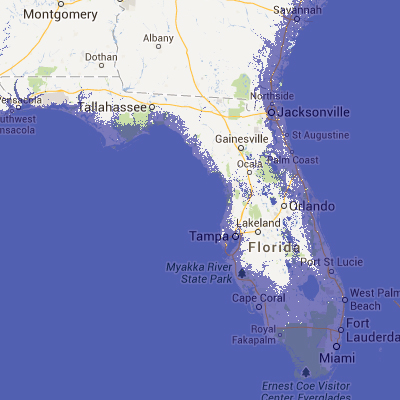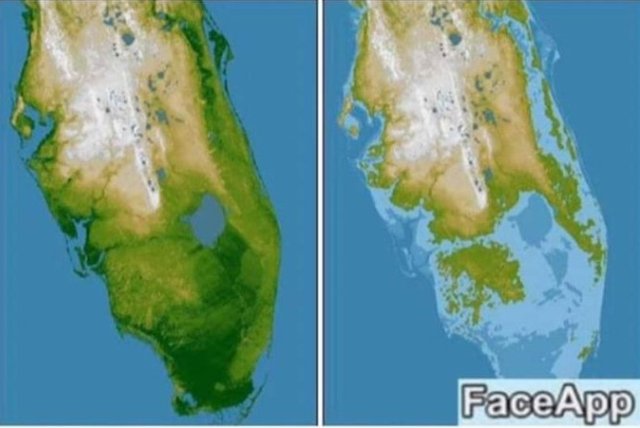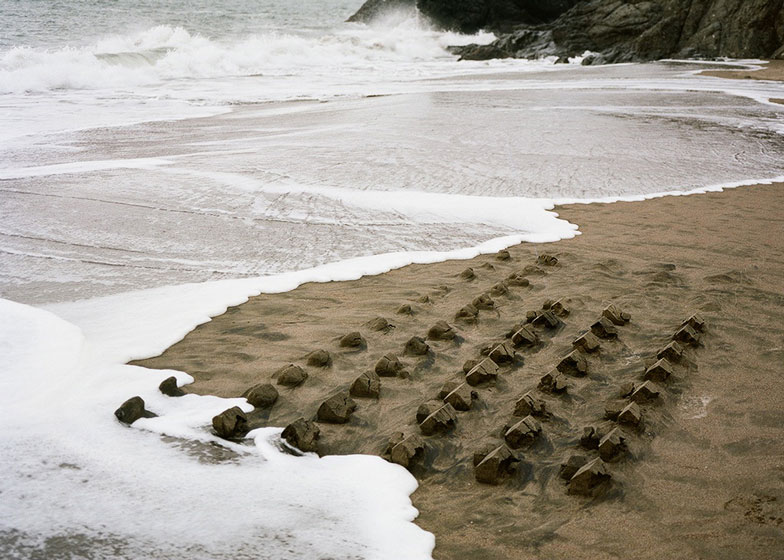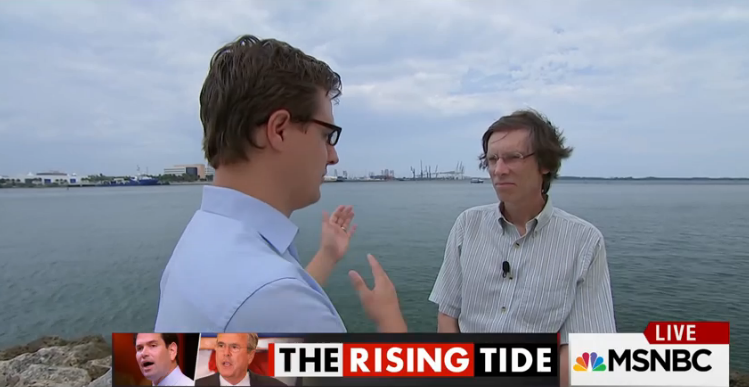Sea-Level Rise
- Geo-Facts to Keep in Mind
As of 2021, about ten percent of the world's population,
approximately 770 million people, live on land less than 5 meters above the high tide line.
The first global elevation model derived from satellite LiDAR data in 2021... finds the worldwide land area less than 2 meters above mean sea level that is most vulnerable to Sea-Level Rise is 649,000 km2 ... 62% is in the tropics. Even assuming a low-end relative SLR of 1 meter by 2100 and a stable lowland population number and distribution, the 2020 population of 267 million on such land would increase to at least 410 million of which 72% is in the tropics and 59% in tropical Asia alone.
Sea-Level change over time... Satellites began measuring sea level precisely in 1992/1993.
Climate Change, Sea-Level Rise + Extreme Weather = 'Climate Migration'
Climate change is increasing the threat posed by hurricanes and cyclones in at least three ways. Rising sea levels mean more storm surge and flooding. Warmer sea surface temperatures increase the frequency and severity of the most intense and damaging storms. And a warmer atmosphere holds more moisture, which leads to elevated rainfall and extreme weather events...
For hundreds of millions living in high threat areas with limited resilience to extreme weather shocks and evacuations, the destruction of recurrent temporary displacement can lead to permanent displacement. For others the risks, costs, and danger of living in high risk coastal areas will produced 'managed retreat' to higher ground to reduce costs and threats. The future of coastline living will recall today's weather, climate, lifestyle decisions and changes producing good and/or damaging outcomes induced by humanity.
NOAA: Sea-Level Rise Interactive Map Viewer
🌎
Hands-on Science: Type NAVD into Google
NOAA provides a key scientific reference tool, 'Datums and Reference Frames'
Monitor sea-level change with dynamic mapping. Track changes in your latitude/longitude, your nation, your community
A "geodetic datum and reference frame" is a coordinate system with a reference surface (such as sea level) that serves to provide known locations to begin surveys and create maps
NOAA and NASA Begin Sea-Level Rise Project (2020)
🌎
GreenPolicy360's geo-home is on the Florida peninsula in North America. We are at "the Frontlines of Climate Change"
The Climate News Florida project was originally organized to prompt a coordinated, cooperative climate-related news effort in Florida. Numerous news publishers, media, and others were approached and after a period of initiatives, the team at the Center for Environmental Studies at the Charles Schmidt College of Science at Florida Atlantic University has run a very successful online "source for news, commentary and educational content about climate change and other environmental issues affecting Florida."
Sign up for FAU's newsletter -- The Invading Sea
Visit friends and colleagues @ "The Invading Sea" for news, opinion, and more about Sea-Level Rise in Florida and far beyond...
🌎
2024
February
Over and Under, the Sea-Rise Coming is a "Complicated" Engineering Challenge
- Consider the Earth Science --- Measuring and Monitoring --- Data from NASA/NOAA
East Coast, United States
2023
December
Want to know if your future home might flood? These states are requiring disclosure
‘It’s a recognition that flooding is only going to get worse and that they need to take action now to protect home buyers and renters
November
State looks to hire ‘chief coastal resilience officer’ to respond to rising sea levels, extreme storms
Via The Boston Herald
Climate change ‘poses a very real threat to our coastal way of life,’ the state Governor says
Gov. Maura Healey announced a new position within the Office of Coastal Zone Management tasked with developing a plan for addressing the impacts of climate change on the state's coastline
October
September
What a ‘climate insurance bubble’ could mean for Florida prices
Floridians are already paying higher insurance premiums than anyone else
By Alex Harris and Nicolás RiveroMiami Herald (TNS)
Rates are skyrocketing for tens of thousands of homeowners. Four private companies have abandoned the state this year, a dozen more have gone belly up in recent years and others have limited coverage after a string of devastating hurricanes, including Ian last year — the most expensive storm in state history. Business has consequently exploded for Citizens, the state-run insurer of last resort, and so has the risk of financial trouble for Florida if a major metro area like Miami or Tampa takes a bad hit.
A new study and a string of recent financial and industry reports suggest it could get even worse for Florida and other states like California and Louisiana ...
The latest study, released Wednesday by the First Street Foundation, warns of a looming “climate insurance bubble” — a double whammy of rising rates and rising risks that potentially could have major economic ripple effects on Florida’s housing market and economy. A bursting bubble would work this way: If rising risks from hurricanes and other climate-drive disasters make insurance too expensive for people to buy homes, or banks to give mortgages to homes in vulnerable spots, it could set off a spiral of declining demand and declining property values.
The report from First Street, a nonprofit that analyses climate threats, suggests some 39 million homes across the country could lose value as insurers begin to calculate climate risks into premiums.
“The biggest problem is we’ve been subsidizing insurance and risk for so long, which ended up ultimately promoting development in risky areas for the last half century or so,” said Jeremy Porter, First Street’s director of research and development. “We’ve built up a climate debt that hasn’t been paid yet.”
~
Saltwater Intrusion, This Is What It Looks Like When It Arrives
“This is just another example of what climate change, drought and sea level rise can look like..."
- https://www.nbcnews.com/science/environment/new-orleans-braces-drinking-water-emergency-drought-stricken-mississip-rcna117218
- https://www.washingtonpost.com/climate-environment/2023/09/21/saltwater-wedge-mississippi-river-drought/
- https://www.cnn.com/2023/09/23/us/freshwater-new-orleans-saltwater-mississippi-river/index.html
The steady creep of a saltwater wedge — which could threaten drinking water supplies in multiple Louisiana communities, undermine agriculture and prove corrosive to infrastructure — has left officials to scramble in an effort to slow down the encroaching sea.
August
Via Curt Anderson / Associated Press
August 31, 2023
Add Idalia to the List of Near-Misses
Another hurricane 'misses a direct hit on Tampa Bay'
Climate Change, Hotter Waters, and Rising Sea Levels Are Increasing Risks
A report from the Boston-based catastrophe modeling firm Karen Clark and Co. concluded in 2015 that Tampa Bay is the most vulnerable place in the U.S. to storm surge flooding and could sustain $175 billion in damage from a major event. A World Bank study a few years earlier rated Tampa as the planet’s seventh-most vulnerable city to major storms.
Yet for years storms have bypassed it. Phil Klotzbach, a research scientist in the Department of Atmospheric Science at Colorado State University, noted that only one of five hurricanes that hit Florida at Category 3 strength or higher has come ashore in Tampa Bay since 1851. “In general, cyclones moving over the Gulf of Mexico had a tendency of passing well north of Tampa,” the National Oceanographic and Atmospheric Administration said in a report on the 1921 storm.
Also lurking in the waves and wind are the impacts of climate change and the higher sea levels scientists say it is causing. “Due to global warming, global climate models predict hurricanes will likely cause more intense rainfall and have an increased coastal flood risk due to higher storm surge caused by rising seas,” Angela Colbert, a scientist at NASA’s Jet Propulsion Laboratory, wrote in a June 2022 report.
○
July
Scenarios for Sea Level Rise
Even if the world stopped emitting greenhouse gases tomorrow, ocean levels would continue to rise
Via The Guardian
Countries from Bangladesh to China, India and the Netherlands, all with large coastal populations, will be at risk. Megacities on every continent will face serious impacts, including Lagos, Bangkok, Mumbai, Shanghai, London, Buenos Aires and New York. (and Miami, New Orleans, Louisiana coast, Texas coast, on and on) ...
“The worst case we’re looking at is something like more than 2 metres in a century." ...
“To put that in context, 2 metres of sea level rise would displace, or would affect or flood on an annual basis, approximately a 10th of the planet’s population, so about 790 million people.” (In 2020, 896 million people lived within the “low elevation coastal zone – a figure probably rising to 1 billion people by 2050.)
The end of the beginning
In all of these cases, it’s important to remember that sea levels won’t stop there – they’ll keep rising long beyond 2100.
These estimates are just the IPCC’s immediate threat assessment for where the world might be by the end of this century.
Ps, Not all 'Adaptations' are ready for sea-level rise -- and severe weather events
○
Sea walls alone won’t save Florida from climate change
By Susan Glickman / Tampa Bay Times
May 2023
○
Seas are rising faster, so Florida must act faster, too
If these higher rates of sea level rise continue, or even accelerate further, property insurance will be disrupted faster and more deeply, with bad consequences for Florida’s real estate market and mortgage lending
○
GreenPolicy360:
- Florida is at the 'frontlines of climate change' in the continental US
“These rapid rates are unprecedented over at least the 20th century and they have been three times higher than the global average over the same period.”
🌎
Rising Seas threaten 'mass exodus' on a 'biblical scale'
An increase in the pace at which sea levels are rising threatens “a mass exodus of entire populations on a biblical scale”, the UN secretary general has warned.
The climate crisis is causing sea levels to rise faster than for 3,000 years, bringing a “torrent of trouble” to almost a billion people, from London to Los Angeles and Bangkok to Buenos Aires, António Guterres said on Tuesday. Some nations could cease to exist, drowned under the waves, he said.
Addressing the UN security council, Guterres said slashing carbon emissions, addressing problems such as poverty that worsen the impact of the rising seas on communities and developing new international laws to protect those made homeless – and even stateless – were all needed. He said sea level rise was a threat-multiplier which, by damaging lives, economies and infrastructure, had “dramatic implications” for global peace and security.
Significant sea level rise is already inevitable with current levels of global heating, but the consequences of failing to tackle the problem are “unthinkable”. Guterres said: “Low-lying communities and entire countries could disappear for ever. We would witness a mass exodus of entire populations on a biblical scale. And we would see ever fiercer competition for fresh water, land and other resources...
🌎
Global 'Early-Stage' Sea-Level Rise Predicted to be Much More Extensive than Previously Thought
Coastal communities in developing countries will be swamped by sea level rise sooner than projected, a new analysis of satellite data shows. More than twice as much land is vulnerable than previously thought. For example, the new data suggest that seas 6.6 feet higher would put most of Bangkok and its 10 million residents below sea level, contrary to previous projections that showed the Thailand capital would still be mostly above sea level.
The more accurate mapping study... analyzed global data from NASA’s ICESat-2 satellite, which uses light detection and ranging (lidar) to get more accurate measurements. A lidar instrument combines information from laser pulses, a scanner and a specialized GPS receiver to generate detailed three-dimensional information of features on the surface of the Earth.
🌎
The US Army Corps of Engineers, Sea Rise, and South Florida: Time to Prepare for an Inundation
The U.S. Army Corps of Engineers has begun looking at updates to South Florida's regional flood control system to address increasing flooding and saltwater intrusion from increased development and sea rise. The system was originally designed to serve just 2 million people.
South Florida’s sprawling flood control system, increasingly unable to handle flood waters worsened by sea level rise and development, is getting a long overdue update.
The U.S. Army Corps of Engineers has now been forced to ask local governments to weigh in and help define the work that needs to be done.
Authorized in the 1948 Flood Control Act, the network of canals, pumps and drainage features was constructed across 18,000 square miles between the 1940s and 1960s when Florida was mostly agriculture. It only anticipated serving a population of about 2 million. With a population that’s about four times larger and rising sea levels, parts of the system have already begun to fail.
In Miami-Dade, damaging flood waters from canal discharges are sickening Biscayne Bay, especially at the north end where scientists are investigating fish kills.
In Broward County, local canals are backing up because stormwater can’t be released to the regional system, known as the Central and South Florida, or C&SF, project.
Read the full article at link above
🌎
2022
December 2022
Sea-Level Rise and 'Power of the Surge'
- Hurricanes and Ocean Wave Force Produce a Powerful Punch
- Research via the Tampa Bay Times
🌎
November 2022
As the 27th international climate conference, COP27, begins the World Meteorological Organization (WMO) that tracks global weather and climate reports: “The rate of sea level rise has doubled since 1993. It has risen by nearly 10mm since January 2020 to a new record high this year. The past two-and-a-half years alone account for 10 per cent of the overall rise in sea level since satellite measurements started nearly 30 years ago.”
The report shows the tipping point for some glaciers in the Alps has been passed; it is too late to save them and to prevent them adding to rising sea levels. The Greenland ice sheet lost mass for the 26th consecutive year, and it rained (rather than snowed) there for the first time in September.
The rate of sea level rise has doubled since 1993. It has risen by nearly 10 mm since January 2020 to a new record high this year. The past two and a half years alone account for 10 percent of the overall rise in sea level since satellite measurements started nearly 30 years ago.
October 2022
Visit GreenPolicy360's 'Climate News Florida' Project
September 2022
The 'Rapid Intensification' of Ian
Hurricane Ian -- Close to Cat 5 -- Jim Cantore reporting
🌎
Climate-induced, warm water in the Gulf of Mexico is a feeder of intensity
🌎
Destructive Surges with Hurricanes, Extreme Weather Events
Florida, we're pointing at Gulf Waters heating up and 'inducing' more powerful storms
Hurricane Ian, September 26, the 'spaghetti plot lines' warn of a historic Gulf Hurricane on the way...
Saffir-Simpson Hurricane Scale: Categories of Extreme Weather Impacts
GFS / Global Forecast System / NOAA
The Global Forecast System (GFS) is a National Centers for Environmental Prediction (NCEP) weather forecast model that generates data for dozens of atmospheric and land-soil variables, including temperatures, winds, precipitation, soil moisture, and atmospheric ozone concentration. The system couples four separate models (atmosphere, ocean model, land/soil model, and sea ice) that work together to accurately depict weather conditions.
🌎
August 2022
Living Shorelines, Natural Defenses, Smart Design
GreenPolicy360: Join Our "Living Coastlines, Living Shorelines" Action
- Managed Wetlands Can Protect Shorelines and Communities
- Eco-system Designs (e.g. Mangrove biospheres) Are Natural Solutions
- Eco-systems Proved Defense Against Hurricanes/Typhoons/Extreme Weather/Ocean Surges/Flooding
- Eco-systems Managed with Local Support Can Work Better than Sea Walls and Constructed Barriers
Are You Near Sea Level? Much of the World Is Near Shoreline / Coastline
- Oh, Florida, Are You Listening?
🌎
Human-driven climate change has set in motion massive ice losses in Greenland that couldn’t be halted even if the world stopped emitting greenhouse gases today, according to a new study published...
...nearly a foot of global sea-level rise.
Disruption of Our Current Era
- What happens in the Antarctic doesn't stay in Antartica
Greenland Ice Sheet Melt Is Severe -- and Sea-Level Rise Is a Reality
Via the Washington Post
Findings in Nature Climate Change project that it is now inevitable that 3.3 percent of the Greenland ice sheet will melt — equal to 110 trillion tons of ice, the researchers said. That will trigger nearly a foot of global sea-level rise.
The predictions are more dire than other forecasts, though they use different assumptions. While the study did not specify a time frame for the melting and sea-level rise, the authors suggested much of it can play out between now and the year 2100.
“The point is, we need to plan for that ice as if it weren’t on the ice sheet in the near future, within a century or so,” William Colgan, a study co-author who studies the ice sheet from its surface with his colleagues at the Geological Survey of Denmark and Greenland...
🌎
Florida, one of the lowest lying and most vulnerable states in the United States
Florida must begin to seriously look at sea-level rise.
Florida has the longest coastline of the lower 48 states, approximately 1,350 miles of coastline. Florida also has the longest Atlantic Ocean coastline of any eastern state.
Southeast Florida, Advancing Resilience Solutions Through Regional Action
• Southeast Florida Regional Compact Climate Change
• Report: 40 percent of Florida property will be ‘highly exposed’ to flooding
One of Florida’s biggest draws is also one if its biggest liabilities — its coastline. A new report projects that Florida is at the greatest risk of any state for tidal flooding caused by rising sea levels. And Tampa Bay faces some of the greatest risk within the Sunshine State.
According to a report by the Union of Concerned Scientists, nearly 40 percent of the state’s property tax base is expected to be "highly exposed" to such flooding within the next 30 years.
• Within 20 years, by 2035, nearly 170 coastal US communities — roughly twice as many as today — will reach or exceed the threshold for chronic inundation, given moderate sea level rise. Seventy percent of these will be in Louisiana and Maryland, where land subsidence is contributing to rapid rates of sea level rise. More than half of these 170 communities are currently home to socioeconomically vulnerable neighborhoods.
• Within 45 years, by 2060, more than 270 coastal US communities — including many that seldom or never experience tidal flooding today — will be chronically inundated, given moderate sea level rise.
• By the end of the century, given moderate sea level rise, nearly 490 communities — including 40 percent of all East and Gulf Coast oceanfront communities — will be chronically inundated.
• Given more rapid sea level rise, nearly 670 coastal US communities will face chronic inundation by the end of the century. This number includes nearly 60 percent of East and Gulf Coast oceanfront communities as well as a small but growing number of West Coast communities.
• Worldwide, the impacts of climate change and sea-level rise will produce profound challenges and test whether humanity is capable of organizing cooperatively to acknowledge, face and confront global environmental change across borders and nations.
·····················································································································
Saltwater intrusion in freshwater sources and aquifers
(Via the Washington Post / Aug 8, 2022)
“Salt is probably the most serious problem in world history related to water,” said Sujay Kaushal, a University of Maryland biogeochemist, adding that the damaging effects on streams and aquatic life are early red flags...
He compared the cumulative effects on the region’s watersheds to the hardening arteries of someone with a high-salt diet.
“Eventually, we know, in the human body, that when you harden the arteries, you create hypertension and all these health problems,” Kaushal said. “It’s the same in the environment. You start crossing these thresholds where you see all these environmental impacts.”
The invasion of salt on freshwater sources “has led to ancient civilizations collapsing,” he said, citing the downfall of Mesopotamia nearly 4,000 years ago. “It affects our food, our drinking water, our air, even.”
The success of that effort — which focuses on best practices for handling road salt, in part through requirements linked to storm sewer system permits — could be a guide for future regulation of streams.
Researchers argue that the need for more regulation is becoming urgent, though they acknowledge that it could be costly for local agencies and complicated in urban areas that have competing needs surrounding economic development and social equity.
“It’s a wicked problem, man, because you’ve got all these different factors coming into play,” said Grant, whose lab is embarking on federally funded research that, in part, will look at how much sodium in drinking water people can live with — data that will inform discussions on ways to change consumer behavior with respect to salt.
More research is needed to better determine how much of an impact the salt is having, said Will Isenberg, a specialist focusing on watershed and ecology issues at the Virginia Department of Environmental Quality.
“Something that we and other states have been requesting of the EPA is to raise the priority of freshwater salinization so that we can have that kind of information,” he said. “If it’s determined that a water quality standard is necessary for whatever ion, then we can weave that into our regulatory programs.”
An EPA spokesperson said the agency is in the process of updating its aquatic life criteria for chloride, informed by the latest research on salt ions.
July 2022
GreenPolicy360: Living Coastlines, Living Shorelines action campaign
Time to Protect, Preserve, Design and Develop Living Systems
'Biodiversity, Biospheres, Managing Nature with Smart Development
🌎
May 2022
HSBC's Stuart Kirk: "Why investors need not worry about climate risk"
Last week, the global head of responsible investments for HSBC Asset Management, Stuart Kirk, made a provocative presentation titled “Why investors need not worry about climate risk” at a Financial Times event in London.
Describing climate risk as a problem in the far-off future, Mr. Kirk said, “Climate change is not a financial risk that we need to worry about,” adding, “Who cares if Miami is six meters underwater in 100 years?”
Watch:
April 2022
Are Concrete and Metal Sea Walls the Answer? Are Sea Walls a Practical Solution for Rising Seas?
The following Opinion piece by Julie Wraithmell takes Florida's largest newspaper to task. GreenPolicy360 agrees with Julie Wraithmell's point of view. Even as the state of Florida is at the frontlines of climate change and climate change's impacts including sea-level rise, the best solutions are not more sea walls. The Editorial Board of the Tampa Bay Times missed the mark in its editorial this week and the director of Audubon Florida writes here of deeper issues, including the multiple problems in building sea walls.
We are republishing the Wraithmell Opinion column in its entirety in keeping with her wish to increase public awareness of this exceptionally important issue as Florida's citizens make choices that will effect the future well being of all on a near sea-level peninsula, one that is surrounded by water and whose geology features porous limestone and karst. Rising seas go over -- and under Florida's topography...
We are adding several links to further extend the importance of what we have called in a GreenPolicy360 campaign, Florida's need for Living Coastlines, Living Shorelines ... Natural Defenses.
Review the coastline science in Cornelia Dean's book "Against the Tide".
- ·········································································
* https://www.greenpolicy360.net/w/File:Against_the_Tide_by_Cornelia_Dean.jpg
- ·········································································
GreenPolicy360: Coastlines, Shorelines, Natural Defenses: Looking to the bigger picture, smarter long-term solutions, preserving (and designing) a living, thriving, resilient coastal environment...
Visit Our Living Coastline Projec
🌎
🌎
Sorry, better sea walls are not the answer to rising seas in Florida | Column
We need 21st century solutions, not antiquated answers that make the problem worse and cost taxpayers money
By Julie Wraithmell
April 30, 2022
In reply to:
Seawalls: One practical way for Florida to prepare for sea-level rise
Tampa Bay Times Editorial Board | Opinion | April 27, 2022
TBT Editor’s note: The author is responding to a recent Tampa Bay Times editorial, “One practical way for Florida to prepare for sea-level rise,” that argued that too many seawalls are already in place in Florida to do away with them anytime soon.
Julie Wraithmell: I read with dismay the perplexing editorial from the Tampa Bay Times’ Editorial Board on investing more in seawalls in the face of climate change. I say perplexing because they are right — action is urgently needed to prepare for the unavoidable impacts of climate change — but an outsized focus on holding back a relentless sea with 20th century technology was naive at best and negligent at worst. There is much we must do to prepare — but an emphasis on this outdated technology is a dangerous distraction from the real work the Tampa Bay area and indeed Florida must undertake.
In the 1900s, Floridians employed seawalls because they didn’t know any better — only later did we learn that seawalls don’t dissipate wave energy and can, in fact, accelerate scouring and erosion on adjacent properties without seawalls, creating an “arms race” wherein everyone needs a wall to avoid erosion. The increased wave energy and elimination of shallow-water habitats negatively impacts everything from seagrass to fish nurseries, which has cascading effects on water quality, fisheries and the food web — not to mention our coastal economies.
Most importantly, seawalls have landed us in the very predicament we find ourselves in today: The illusion of safety they provided allowed irresponsible development in hazardous coastal locations. Defending these poor choices is the equivalent of throwing good money after bad — but the good money is that of taxpayers and our environment paying to defend ill-advised, private waterfront investments of the past.
True, where they exist now, seawalls need to be maintained in compliance with state permitting conditions — just as they always have. But assuming the answer to sea level rise is building higher, wider, longer is short-sighted and comes at the expense of Tampa Bay. We have 21st century solutions that work with nature to protect the built environment — green and gray infrastructure like wave attenuation reefs that create calm water shorelines to stop erosion, provide habitat for oysters and drive a vibrant food web.
Paired with mangroves, they can protect communities and environmental resources, rather than having to choose between them. Audubon has already used these solutions in our work to protect the Richard T. Paul Alafia Banks Sanctuary in Hillsborough Bay. These tools are not just the future, they are now.
Coastal engineering is not the only step we urgently need to take. Remember: Flooding from sea level rise doesn’t just happen at the waterfront. When storm sewers and drainage systems that ordinarily depend on gravity no longer have a gradient — because sea level is no longer lower than the area being drained — they stop working. Storm events with extreme rainfall cause community flooding with nowhere for water to go. And high tides can actually use these drainage routes to flood communities even on blue sky days.
To add insult to injury, the communities who often feel these impacts the most are historically excluded, low income and communities of color. Seawalls do nothing to solve this problem — they only protect coastal property owners. Coastal protections start with inland land conservation. Restoring and preserving green spaces and landscapes in inland communities slows down water rushing to the coasts after storm events. Historically, naturally occurring wetlands absorbed stormwater flooding on our landscape. Protecting our remaining wetlands and restoring those that are lost is not just an exercise in bunny hugging, it’s an investment in the resilience of our communities — all of them.
Finally, we have to take a hard look at our land use decisions. In the 1950s, we thought we could out-engineer the ocean, making risky locations safe for development. Today we recognize the arrogance of that strategy — as well as the very public cost to taxpayers and our environment for the benefit of waterfront property owners.
Florida’s environment is our economy — think only of the impacts to tourism and property values from 2010′s Deepwater Horizon disaster, or last summer’s Piney Point disaster and accompanying harmful algal blooms. Calling for such a heavy and continuing reliance on seawalls while we continue to allow building in vulnerable locations is truly sticking our heads in the sand, rather than the clear-eyed pragmatic leadership our coastal residents will need to survive and thrive in this changing Florida.
Julie Wraithmell is the executive director of Audubon Florida and the vice president of the National Audubon Society.
···················································································································
Business leaders call for billions to combat sea rise
News to Highlight and Act On: On the Edge in Florida
GreenPolicy360: Here in one of the most vulnerable areas in the world susceptible to the effects and disruptions of climate change, the Tampa Bay area is beginning to see the future -- and it isn't a picture most want to see. The previous Florida governor was a science denier when it came to climate change. The current Florida governor in 2021 signed into law SB 1128/HB 919, “Preemption Over Restriction of Utility Services,” which was pushed through the legislature. It prevents local governments from deciding which energy path they want to take. In other words, Florida towns and cities are now unable to switch to 100% clean energy because they can’t ban fossil fuels.
As of late 2019, Florida cities making the commitment to 100% clean energy include Tallahassee, Gainesville, Orlando, Satellite Beach, Dunedin, Largo, Safety Harbor, St. Petersburg, Sarasota, and South Miami Beach.
So now each of these cities can no longer pursue 100% clean energy initiatives, as former governor and congressman Charlie Crist (D-FL), who is running against governor DeSantis in 2022, confirms (the news about the state's move away from renewable energy...
Looking at the present reality of Florida politics, we can acknowledge that green politics here is no walk in the park. The upside is that there is some movement on preparations for "resilience" and "adaptation" to the winds of change and sea-lever rise. The Tampa Bay Resiliencey Coalition, in which your GreenPolicy360 org participates as the region is our terrestrial home base, has recently held a summit and is now organizing government units and business, educational institutions and the public, to plan for the changing climate. We'll see how far and how fast our local citizenry gets going and acts to acknowledge the science and the facts... even as the future's challenges grow closer and much more serious.
ST. PETERSBURG — Building up Tampa Bay to keep it safe from rising seas and storms over the next 50 years could save the region more than $2 for every $1 it spends, according to a new report.
The suggested price tag for those upgrades is enormous: $13.4 billion.
“This is about what our region needs to do to be ready for what is going to be inevitably devastating results of sea level rise,” said Brian Auld, president of the Tampa Bay Rays and chair of the Tampa Bay Partnership’s Resilience Task Force, which commissioned the report and released it Tuesday. “It’s obviously going to take every single one of us to get it right.”
The region could lose $16.9 billion in property values by 2070 because of high-tide flooding alone from Citrus through Manatee counties, the report says. At the same time, governments could lose $238 million every year because of declines in property, sales and tourism taxes.
To protect the region from flooding, the report recommends an array of options, including raising and replacing seawalls; constructing berms; replenishing eroded beaches; and elevating homes. It relies on a projection that shows St. Petersburg could see 3.4 feet of sea level rise by 2070, compared to the year 2000. The study estimates losses and savings in 2021 dollars.
Severe weather will add to the cost. A storm that has a 1-in-10 chance of occurring in a given year, the report found, could in 50 years cause several billions of dollars in property damage from flooding...
https://tampabaytimes-fl.newsmemory.com?publink=1084e191d_134841a
March 2022
'Frontline Florida: Living on the Climate Edge'
(GreenPolicy360: For many years GreenPolicy360 has been out in front reporting an exceptional fact: Florida is a largely limestone, a karst peninsula geologically. Much of Florida and its extensive ocean front real estate can be spoken of as "porous" and, as a result, sea-water intrusion occurs both "over and under". Florida has one of the planet's most expansive networks of underground springs, waterways, caves, aquifers moving and shifting dynamically, due to its subterranean hydrology. We, GreenPolicy360, continue our advocacy of 'measuring and monitoring' using science, facts and data as a policy-making guide, even as climate change denialism and inadequate attention to risk management, trendlines and education slow and prevent needed actions... We will keep reporting and advocating, using good science. Let's hope for a shift in political and public vision. Actions need to happen now to prepare for what is at our 'doorstep'.)
Factoid: Florida has 8,436 miles (13,576 km) of coastline, according to the National Oceanic and Atmospheric Administration, the second highest number of shore miles in the U.S. by distance.
The terms “coastline” and “shoreline” are often used interchangeably, but they have different meanings. The coastline of a place is defined as the boundary between the coast and the shore. In other words, a coastline is a big-picture view of the approximate line between the land and the sea. A shoreline is an ever-changing line that marks the specific place where the water and shore meet...
Florida’s sea levels are increasing faster than the global rate — an astonishing 6 inches in the past 25 years in Miami — due in part to ocean currents in the area. Saltwater inundation of the city streets — so-called sunny day flooding — is up 400 percent since 2006. A greater proportion of hurricanes are reaching catastrophic intensities, with the potential to drive a deeper and more destructive storm surge farther inland.
Unlike in New York or the Netherlands, there is no known way to stop the surging seas from affecting southern Florida. The area lies on top of porous sand and limestone, so dikes and seawalls are ineffective in keeping the water out. The highest elevations along the densely populated coastal ridge from Fort Lauderdale south are generally at or below 25 feet, while the Florida Keys and inland locations closer to the Everglades sit much lower at 3-feet elevation or less.
February 2022
“I really feel like this was completely missed,” Parkinson said. “You can see coastal erosion. You can see if you’re losing your shoreline or if your property gets flooded. But what you don’t see, and what people really hadn’t begun to think a lot about, is everything that’s occurring hidden underground. It’s out of sight, out of mind.”
Surfside collapse exposes an overlooked threat: Saltwater rising from underground
Researchers, environmental activists and a number of Florida legislators are trying to sound the alarm about the danger rising seas could pose to coastal buildings
································································································································
Florida Governor DeSantis wants to deal with Florida’s sea level rise "without 'left-wing stuff"'
- Yes, it still looks like Florida's governor just doesn’t get it
- The inaction of the previous Florida governor, now a Senator who is seen as a 'climate change' denier, led to what is referred to as a 'lost decade' on climate action
- Refusing to see and act to face the challenges, the consequences, the multiple threats of climate change and climate disruption should be called "political malpractice"
Rising Threat Project, Climate Change, Rising Seas
- Extreme Weather, Disruption, Community & Habitat Impacts
- Real Estate Losses, Life, Economic & Environmental Consequences
Are We Ready for What's Ahead of Us?
Planning for Change? Re-thinking Priorities? Acting to Address the Causes of Climate Change?
One community in Florida looks ahead and sounds a warning... Look around, don't ignore reality
🌎
Part 1
~
Part 2
~
Part 3
Read More at the Tampa Bay Times -- www.tampabay.com
Southwest Florida: Here we are, your GreenPolicy nexus
The terrestrial home of GreenPolicy360 is in Clearwater, Florida, literally a few meters from the edge of Tampa Bay.
Near sea-level South Florida is considered one of the most vulnerable places in the U.S. to sea-level rise and extreme weather events (hurricanes!)
We are sentinels of things to come and signaling risks to coastlines across the globe. Look to the extent (~70%) of Earth that is ocean as we measure and monitor the extent of sea rise at ocean's 'edges'...
Planet Citizens, Planet Scientists
Case Study: 'Witness to a Shifting Baseline'... Florida at Frontline Science of Sea-Level Rise
Focus: South Florida's Drinking Water Could Go First
- On a Limestone Peninsula that Arose from a Sea-Shell Seabed, a Porous Geography Presents Reality
····················
December 2021
Sea-level Rise is a Reality Across the Earth
Blue Planet
- Earth=Water=Life: The ocean covers 70 percent of the Earth's surface. It contains about 1.35 billion cubic kilometers (324 million cubic miles) of water, which is about 97 percent of all the water on Earth. The ocean makes all life on Earth possible, and makes the planet appear blue when viewed from space.
November 2021
October 2021
Moving to Higher Ground
- by John Englander
·············································································
Measuring Sea-level Rise Along the Coasts
Risk analysis: FL among four states most threatened by climate-caused flooding
One-fourth of U.S. critical infrastructure at risk of flooding
Cape Coral, Florida West Coast City, Opposes Federal Hikes in Flood Insurance
The price of living near the shore is already high. It’s about to go much higher
U.S. FEMA prepares to remove subsidies from its flood insurance, a new assessment says 8 million homeowners in landlocked states are at risk of serious flooding because of climate change
Via The Washington Post
September 2021
Flood Insurance Costs Are Set to Skyrocket for Some
Via The New York Times
New federal flood insurance rates that better reflect the real risks of climate change are coming. For some, premiums will rise sharply.
August 2021
The Netherlands: World Leader in Engineering Solutions to Manage Storm Surges and Rising Seas
July 2021
With sea-level rise, public access to beaches is shrinking
... as climate change raises sea levels, property owners are trying to harden their shorelines with sea walls and other types of armoring, squeezing the sandy beach and the public into a shrinking and diminished space.
As director of the Conservation Clinic at the University of Florida College of Law and the Florida Sea Grant Legal Program, and as someone who grew up with sand between my toes, I have studied beach law and policy for most of my career. In my view, the collision between rising seas and coastal development – known as “coastal squeeze” – now represents an existential threat to beaches, and to the public’s ability to reach them.
Study Projects a Surge in Coastal Flooding, Starting in 2030s
$26 Billion Plan to Save the Houston Area From Rising Seas
Lawmakers are poised to decide the fate of a massive project to protect the Texas coast from surging seawater
Via Undark - Climate Desk - Wired
Ike Dike to protect Galveston Bay?
Multibillion-dollar coastal megaprojects already are underway or under consideration from San Francisco to Miami to New York City
President Joe Biden’s new $2 trillion national infrastructure initiative specifically calls for projects on the country’s embattled coasts
·····················
June 2021
Rising Seas and Risk to Coastlines
From Florida to Mumbai, Get Ready to Deal with Threats to Infrastructure
The region abuts seas that are around eight inches higher than they were a century ago and this pace will quicken – with another 17in of sea level expected by 2040. Depending on the melting of the vast ice sheets of Greenland and Antarctica, south Florida could be assailed by a foot of extra sea level per decade in the second half of this century, according to Harold Wanless, a geographer at the University of Miami.
“It’s going to be an enormous to impossible job everywhere to deal with that,” Wanless said. “The sea level rise is accelerating and will do so more dramatically than most people anticipate.
“Every sandy barrier island, every low-lying coast, from Miami to Mumbai, will become inundated and difficult to maintain functional infrastructure. You can put valves in sewers and put in sea walls but the problem is the water will keep coming up through the limestone. You’re not going to stop this.”
Collapse of Condominium Building near Miami
Multiple Deaths, Over One Hundred People Missing
Could the increasing assault of king tides and sea level rise have contributed to Miami condo collapse?
“Sea level rise does cause potential corrosion and if that was happening, it’s possible it could not handle the weight of the building,” said Zhong-Ren Peng, professor and Director of University of Florida’s International Center for Adaptation Planning and Design. “I think this could be a wakeup call for coastal developments.”
Sea level rise, the gurgle of more frequent king tide flooding, and changes in soil consistency or location are elements dealt with by any building on a barrier island... it can be invisible machinations — the push and pull of tides on limestone bedrock — combined with rising seas that can weaken a building’s integrity.
South Florida's coastal waters could jump 10 to 17 inches by 2040 and 21 to 54 inches by 2070 above the 2000 mean sea level in Key West. The long-term sea-level rise is predicted to be 40 to 136 inches by 2120.
From GreenPolicy360's Siterunner
·······················
Charleston
The Post and Courier, Pulitzer-prize finalist for investigative news series on rising seas and threat to the city
About Rising Waters
Flooding poses a dire threat to the Carolina region. The Post and Courier plans to tell that story in real time.
During the last century, sea levels in Charleston rose at a rate of an inch every decade. Now it’s an inch every two years. As the atmosphere warms, tropical storms, including last year’s Hurricane Dorian, hold more moisture, unleashing record-breaking amounts of rainfall.
This, combined with the effects of lunar events and king tides, contributed to Charleston flooding nearly one out of five days in 2019 — a record 89 times in all.
It’s a climate emergency, but its incremental nature dampens perceptions and masks impacts. So The Post and Courier is investing significant manpower and resources this year to capture and illustrate the crippling effects of sea rise and flooding on people’s lives and the greater Charleston economy.
- ·········································································································
- ·········································································································
A 20-Foot Tall Sea Wall? Miami Faces the Hard Choices of Climate Change
Proposal to construct barriers for storm surge protection forces South Floridians to reckon with the many environmental challenges they face
By Patricia Mazzei / New York Times
June 2, 2021
Build a wall
The U.S. Army Corps of Engineers proposed in its first draft of the study, now under review. Six miles of it, in fact, mostly inland, running parallel to the coast through neighborhoods — except for a one-mile stretch right on Biscayne Bay, past the gleaming sky-rises of Brickell, the city’s financial district.
We are looking at "Generational questions"...
·····················
May 2021
'Ghost forest' die-offs extending up and down US Atlantic coast due to sea-level rise and saltwater intrusion
Artist Maya Lin creates a ‘Ghost Forest’
Via Reuters
May 16, 2021
In the center of New York City’s spring greenery, artist Maya Lin has installed the leafless, brown trunks of 49 dead Atlantic white cedar trees in a Manhattan park. The installation is a “Ghost Forest” to warn of the danger of climate change and the threat of rising seawater.
“This is a grove of Atlantic cedars . . . victims of saltwater inundation from rising seas due to climate change,” said Lin, designer of the Vietnam Veterans Memorial in Washington, D.C. ....
- (Ghost Forest Audio Tour) https://madisonsquarepark.org/art/exhibitions/maya-lin-ghost-forest/
- ··················
- ··················
Florida Climate Institute
Who We Are
The Florida Climate Institute (FCI) is a multi-disciplinary network of national and international research and public organizations, scientists, and individuals concerned with achieving a better understanding of climate variability and change.
The FCI has eleven member universities – Florida A&M University (FAMU); Florida Atlantic University (FAU); the Florida Institute of Technology (FIT); Florida International University (FIU); Florida State University (FSU); Nova Southeastern University (NSU); the University of Central Florida (UCF); the University of Florida (UF); the University of Miami (UM); the University of South Florida (USF); and Stetson University (SU) – and is supported by relevant colleges, centers, and programs at these universities. UF and FSU initiated the FCI in 2010; FAU, UCF, UM, and USF formally joined in 2012; FIU formally joined in 2013; FAMU formally joined in 2014; FIT formally joined in 2015; and NSU formally joined in 2017.
The Climate Issue
Climate variability and change pose significant economic, food security, and environmental risks worldwide. Drought, storms with heavy rain, high winds, flooding, and freeze events cause billions of dollars in losses to the agricultural and natural resources sectors locally in Florida and globally. The Fourth Assessment Report (AR4) of the Intergovernmental Panel on Climate Change (IPCC) predicts that by the year 2100 global average temperature is likely to increase by 1.1 to 6.4°C (2 to 11.5°F), global mean sea level will rise from 0.18 to 0.59 m (7 to 23 inches), and increases in precipitation intensity and variability will increase the risk of both flooding and drought. The IPCC AR4 also states that many regions will experience considerable deviations from the global averages and there is tremendous uncertainty regarding the regional and local impacts of global changes. Some regions will warm more than the global average while others will warm less or even cool.
Much of the climate change information communicated to the public is based on IPCC projections that are both at the global level and relatively long-term (50 to 100 years). However, many climate stakeholders, including policy makers, farmers, and the public, also need information at local to regional levels and at shorter time scales. Climate stakeholders want reliable, scientifically-sound, region-specific climate information at multiple time scales to help evaluate various options for climate change adaptation and mitigation.
···························································
At long last, a Florida governor acknowledges climate change and rising-sea levels
First steps, but far to go in making real progress to deal with the coming climate crisis
Susan Glickman, Florida Director at Southern Alliance for Clean Energy
While it's progress to see Governor DeSantis and Florida's Republican leadership at long last acknowledge the harm local communities are seeing because of climate change, this legislation does nothing to get at the root of the problem. Continuing to pollute will cause even more costly sea rise. What's required is a transition to clean energy solutions which saves money, creates local jobs and protects our state from the threats of a warming planet.
- ···························································
Will you be above water? How high is your home, how resilient is your community?
Elevation, elevation...
Global heating pace risks ‘unstoppable’ ... sea levels rise ... Antarctic ice sheet melts
World faces ‘abrupt jump’ in pace of ice loss around 2060 unless emissions reduced to meet Paris agreement goals, (another) study warns
Findings
- The current pace of global heating risks unleashing “rapid and unstoppable” sea level rise from the melting of Antarctica’s vast ice sheet
- Unless planet-heating emissions are swiftly reduced to meet the goals of the Paris climate agreement, the world faces a situation where there is an “abrupt jump” in the pace of Antarctic ice loss around 2060
“Once you put enough heat into the climate system, you are going to lose those ice shelves, and once that is set in motion you can’t reverse it. The oceans would have to cool back down before the ice sheet could heal, which would take a very long time. On a societal timescale it would essentially be a permanent change... It’s really the next few decades that will determine the sea level rise from Antarctica. These ice shelves won’t be able to just grow back.” -- Robert DeConto, University of Massachusetts
Antarctic ‘doomsday glacier’ may be melting faster than was thought
The fate of Thwaites – nicknamed the doomsday glacier – and the massive west Antarctic ice sheet it supports are the biggest unknown factors in future global sea level rise.
Over the past few years, teams of scientists have been crisscrossing the remote and inaccessible region on Antarctica’s western edge to try to understand how fast the ice is melting and what the consequences for the rest of the world might be.
“What happens in west Antarctica is of great societal importance,” said Dr Robert Larter, a scientist with the British Antarctic Survey and principal investigator with the International Thwaites Glacier Collaboration, the most ambitious research project ever carried out in Antarctica. “This is the biggest uncertainty in future sea level rise.”
···························
April 2021
Putting Wetlands to Work for Natural Disaster Recovery
Audubon's new policy platform lays out the need for natural infrastructure
Strategies to deal with consequences of sea-level rise and extreme weather events
Audubon presents a new suite of policy recommendations for making our communities and wildlife more resilient to climate change, by putting our wetlands, barrier islands, and other ecosystems to work... More than 41 million Americans face rising flood risks, and $1 trillion in properties in the U.S. are threatened by sea-level rise alone.
Natural infrastructure presents an opportunity for addressing climate threats to both birds and communities, while putting people back to work in safe, high-paying restoration jobs. Natural infrastructure is engineering with nature. It involves restoring and mimicking natural landscapes like wetlands to buffer communities against flooding, enhance habitats for birds and other wildlife, and absorb carbon pollution—delivering multiple benefits for communities and birds.
By protecting natural barrier islands and restoring marshes, we can shore up these first lines of defense that protect communities against storm surge and rising seas... (B)y incorporating climate-resilient rebuilding practices and nature-based approaches into our disaster recovery and hazard mitigation programs.
······················································
Oh, Florida, Adapt and Change
Publisher : The Science Bookshelf (April 6, 2021)
By John Englander
About the Author
John Englander is an oceanographer, multi-book author, speaker, and expert on climate change and sea level rise. His 2012 book, High Tide on Main Street explained the science in easy-to-understand terms. Politico listed it as one of the top fifty books to read. His broad marine science background, coupled with explorations in Greenland and Antarctica, allows him to see the big-picture impacts of changing climate and rising sea level on society. Millions of people in the US and around the world have read his books, or heard his message through blogs and popular talks. Englander is consistently rated as one of the best speakers on climate change and sea level rise, and works tirelessly to help communities understand why sea level will rise far higher than most can imagine... As a leading spokesperson for "intelligent adaptation", John Englander advocates that, globally, we must move to higher ground. John's background as a scientist, explorer, entrepreneur, and CEO (International SeaKeepers Society, Cousteau Society) combine to help him analyze not just the scientific impacts of profound sea-level rise (SLR), but also the business, economic, and humanitarian impacts.
About the Book
···························
March 2021
President Biden’s Chance to Save the Everglades
It may be the most ambitious ecosystem recovery project ever, not just in the United States but anywhere, and it has the added virtue of being an act of atonement for past government failures. The project in question, launched near the end of the Clinton administration, is an effort to restore the biological health of the Florida Everglades. Originally funded at $7.8 billion, the program is now more than 20 years old, and while some progress has been made, it has moved in fits and starts. It is now at a critical point, with several major plans on the cusp of success if the money can be found. Decisions taken in the next few months may well determine whether the Everglades project lives up to its promise of reviving the South Florida ecosystem...
America’s greatest subtropical wilderness... It is a magnet for tourists drawn to Florida’s environmental assets, and thus provides permanent jobs apart from those created by the restoration projects. Its aquifers furnish drinking water for millions of Florida’s residents. It protects against saltwater intrusion caused by slowly rising sea levels, and its mangroves absorb and store carbon dioxide.
GreenPolicy360: Again, we must point at a hidden threat: Saltwater intrusion. The Everglades can protect against this rising threat to southern Florida. The Florida peninsula to a large extent is porous, limestone, karst, and the rising seas, salt water, moves easily as it intrudes under and not just over the land. The drinking water, the fresh water that is essential, is being threatened by sea-level rise. It's all connected, as the saying goes. Miami and the development up and down the coast, be aware. Prepare now. Move politically, educate, act to save the health of the environment...
··································································
Fighting the Rising Sea in California
Proposed federal spending up to $100 million a year to deal with rising seas-flood impacts, but the causes of sea-level rise? Not addressed in the legislation.
Bills in the Florida Legislature would thwart cities’ efforts to address the threats from the warming climate
The bills have appeared in many other states and suggests the likelihood of a coordinated campaign by oil, gas and utility lobbyists
································
February 2021
Florida needs a Resilience Officer
A bill before the Legislature would create a permanent Chief Resilience Officer and a Statewide Office of Resilience. Florida needs a Resilience Officer who will make sure that solutions to address climate change are cohesive and well-executed.
································
January 2021
Long-time Florida Writer Talks of the State's Climate-Change Denying Former Governor, Now Senator
After years of evading the basics of Climate Change Florida's current US Senator (and Republican Party legislative US Senate leader) Rick Scott must change his position on Climate Change
The Risks to Florida are Real and Present Dangers
Groundwater is Rising as Sea Level is Rising
Miami are you ready?
································
December 2020
Florida Politics Ignores the Threat of Rising Seas, Extreme Weather, Heat, Environment
Top eco-legislator loses legislative position due to political 'trick'
November 2020
Sentinel-6 Michael Freilich Mission -- Successfully launched, November 21, 2020 - #ClimateChange data .... the Sentinel-6 Michael Freilich satellite has begun its mission to space to collect the most accurate data yet on global sea level and how our oceans are rising in response to climate change.
BERLIN (AP) — A "climate guardian" satellite set for launching this weekend will greatly help scientists keep track of the rise in sea levels, one of the most daunting effects of global warming, a senior official at the European Space Agency said on November 20th.
The satellite, known as Sentinel-6 Michael Freilich and jointly developed by Europe and the United States, contains cutting-edge instruments able to capture sea surface height with unprecedented accuracy, adding to space-based measurements going back almost 30 years.
“This is an extremely important parameter for climate monitoring,” said Josef Aschbacher, the European Space Agency's director of Earth observation.
Billions of people living in coastal areas around the planet are at risk in the coming decades as melting polar ice and ocean expansion caused by warming push waters ever higher up the shore.
“We know that sea level is rising,” Aschbacher said. The big question is, by how much, how quickly.
Low-lying regions from Bangladesh to Florida will be most at risk...
VANDENBERG AIR FORCE BASE, Calif. (AP) — A U.S.-European satellite designed to extend a decades-long measurement of global sea surface heights was launched into Earth orbit from California on Saturday (November 21, 2020).
A SpaceX Falcon 9 rocket carrying the satellite blasted off from Vandenberg Air Force Base at 9:17 a.m. and arced southward over the Pacific Ocean. The Falcon’s first stage flew back to the launch site and landed for reuse.
The Sentinel-6 Michael Freilich satellite was expected to deploy its solar panels and later make first contact with controllers.
Named for a former NASA official who had a key role in developing space-based oceanography, the satellite’s main instrument is an extremely accurate radar altimeter that will bounce energy off the sea surface as it sweeps over Earth’s oceans. An identical twin, Sentinel-6B, will be launched in 2025 to ensure continuity of the record.
Space-based sea level measurements have been uninterrupted since the 1992 launch of the U.S.-French satellite TOPEX-Poseidon, which was followed by a series of satellites including the current Jason-3.
Sea surface heights are affected by heating and cooling of water, allowing scientist to use the altimeter data to detect such weather-influencing conditions as the warm El Nino and the cool La Nina.
The measurements are also important for understanding overall sea level rise due to global warming that scientists warn is a risk to the world’s coastlines and billions of people.
“Our Earth is a system of intricately connected dynamics between land, ocean, ice, atmosphere and also of course our human communities, and that system is changing,” Karen St. Germain, NASA’s Earth Science Division director, said in a pre-launch briefing Friday.
“Because 70% of the Earth’s surface is ocean, the oceans play an enormous role in how the whole system changes,” she said.
The new satellite is expected to have unprecedented accuracy.
············································································································
Florida media coalition receives grant for climate change work
by David Fleshler, Florida Climate Reporting Network
“Florida businesses have a lot at stake as the climate warms, the seas rise and coastal communities experience chronic flooding,” said Tom O’Hara, editor of The Invading Sea. “Those who are paying attention know more must be done to prepare and prevent the situation from getting worse.”
Craig Pittman (@craigtimes) Tweeted:
Florida is the state most vulnerable to #climate change, yet a majority of #Florida voters chose the presidential candidate who calls #climate change a hoax
- https://t.co/j8tmW8qeJT via @CasselsVFR
October 2020
Florida Sees Signals of a Climate-Driven Housing Crisis
Home sales in areas most vulnerable to sea-level rise began falling around 2013
September 2020
Via YaleEnvironment360 / Sept. 29
As Miami Keeps Building, Rising Seas Deepen Its Social Divide
Ignoring sea level rise and intensifying flooding, Miami has continued to build luxury real estate near the water at a rapid pace. But as developers eye higher ground, communities of color will likely bear the heaviest burden from the changes wrought by climate change.
Via Bloomberg Businessweek / Sept. 24
Florida Braces for a Storm of Homeowners Insurance Rate Hikes
The peculiar dynamics of reinsurance and climate have inched the state of Florida toward the precipice of an insurance disaster. Simply put, homeowners’ premiums are set to become very, very expensive.
Seas Are Rising. We Must Create Climate-Resilient Infrastructure — Now
Via Truthout
············································································
····························
August 2020
Ft. Lauderdale, Florida
Coastal city prepares and begins to pay for sea-level rise flooding
Coastal cities and towns get a glimpse of the future
E&E News (@EENewsUpdates) Tweeted:
Conservationists are raising concerns that the federal government's flood maps fail to account for climate change and increased flooding, and as a result allow developers to build in flood-prone areas without understanding the risk.
July 2020
Cost? Billions to get Tampa Bay ready for future severe weather
- Tampa Bay Regional Planning Council releases a “Project Phoenix”
- Project Phoenix 2.0: The Recovery
- A Hurricane Simulation for Tampa Bay Small Businesses & Emergency Management Agencies
- What if a Category 5 hurricane struck the Tampa Bay region? How would the events unfold, and what would the region look like in the aftermath of the storm? #ExtremeWeather #ClimateChange
- Project Phoenix 2.0: The Recovery is a facilitated training exercise that examines critical issues and capabilities of Tampa Bay area small businesses and emergency management agencies during disaster recovery. A series of videos supplement the exercise; illustrating a simulated Category 5 hurricane hitting Tampa Bay paralleled with lessons learned and words of advice from small business owners impacted by Hurricane Michael with its severe damage in Florida in 2018.
···························································································
New Florida Law Addresses Sea-level and Climate Change
Via PBS-WJCT news reports
Florida Governor Ron DeSantis has signed a bill that would require state-financed coastal developments to account for sea level rise and storm surge.
“This bill really is the first transformative piece of legislation on climate the legislature has ever passed,” said Miami Democratic Senator Jose Javier Rodriguez, who introduced SB 178. “It says climate change is real, it’s here, and we have to plan for it when we’re spending state taxpayer dollars.”
The bill requires any public entity initiating a coastal project, whether a state agency or local government, to hire an engineer to complete a sea level impaction projection, or SLIP, study, according to guidance from the Department of Environmental Protection.
“That's, I think, a cost that all of us are willing to bear to make sure that we're not wasting billions of dollars over the next couple of decades on new construction and on improvements to publicly funded projects that could have been done more wisely,” said Rodriguez.
The results of all SLIP studies will be posted on the Environmental Protection Agency’s website.
Next steps and required public or government actions are not indicated in the new law.
○
Christopher Flavelle / Bloomberg News / Tracking Climate & Environment
The Nightmare Scenario for Florida’s Coastal Homeowners
·······················
June 2020
May 2020
NASA Eyes on the Earth
Earth Science Research from Space
Thanks to altimetry missions, beginning with the U.S.-French TOPEX / Poseidon mission launched in 1992 and continuing through the present with the Jason series, we now have a nearly three-decade-long record of sea level change.
NASA earth science: "The satellites tell us it's happening. But we want to know why—what's causing it?" said Josh Willis of NASA's Jet Propulsion Laboratory in Southern California. "Generally speaking, it's global warming. But in a specific sense, how much is it the melting of polar ice sheets as opposed to glaciers? And how much is it ocean warming and thermal expansion?" he said, referring to how water expands as it warms. "Most importantly, what's going to happen in the future?"
NASA scientist goes on a seaside vacation
April 2020
Florida, 'Sunshine State', Do You Feel Lucky?
Corporate Investors McKinsey Report, or Handed-off Real-Estate Brochure, Florida's at Serious Actuarial Risk
McKinsey: Will mortgages and markets stay afloat in Florida?
Actuarial science... data collection, measurement, estimating, forecasting, and valuation tools
- Actuarial science... assessing overall risk from catastrophic events...
Legacy: Years of Climate Change Denial by former Florida Governor & current US Senator Rick Scott
As Time Goes By
From Bell Science Hour & Frank Capra
Produced & Distributed in 1958
We are heating the atmosphere, disruption is coming
Glass-bottom boats touring over Miami?
······························································
Exponential Coastal Flooding Coming
The accelerating pace of sea level rise means that by the end of the century floods currently considered once in a lifetime, or once every 50 years or so, will become a daily high tide occurrence for more than 90% of the coastal locations assessed by researchers from the US government, the University of Illinois at Chicago and the University of Hawaii.
Within 30 years from now, these now-rare flooding events will become annual occurrences for more than 70% of the locations along the US coast according to the research published in Scientific Reports. This scenario threatens huge, multibillion-dollar damages and, potentially, the viability of some coastal communities.
Planning to Retreat from the Coasts
Then there are those who say 'what does the USGS know?' And then there are those who say 'so what's the USGS?'
···························
March 2020
"Miami Beach Fights a Tide of Angry Residents"
Via Wall Street Journal
······················································
Is Florida up for the Challenge?
“The idea that what’s land and what’s ocean, that the boundary line is going to move, is a really tough, disturbing concept,” says John Englander, a Boca Raton-based oceanographer, climate consultant and author. "The good news is, we have time to begin adapting."
A Case Study, Red Hook, NYC: Adapting to Climate Change, Flooding and Mold
··································
GreenPolicy360: Good Science, Smart Planning
Resilient Strategies
GreenPolicy 'Living Coastline, Living Shoreline' Campaign
Prepare for the Future Now
······································
Cornelia Dean Brings Us a Story of American's Beaches & Failed Attempts to Fight Off Rising Tides ....
- ······································································································
California’s New Plan to Deal w/ Climate Change & Sea-level Rise
··································
February 2020
Clearwater, Florida: Forward-planning for regional resiliency
Coastal communities facing severe impacts of climate change: Discussing, debating, deciding... politics in a time of climate change and climate impacts
····································································································
Acceleration
• The highest rate of sea level rise was recorded along the Gulf of Mexico shoreline.
“Acceleration can be a game changer in terms of impacts and planning, so we really need to pay heed to these patterns,” says John Boon, emeritus professor and founder of Virginia Marine Institute’s project to chart sea level rise.
The US’s National Oceanic and Atmospheric Administration (NOAA) has reported an acceleration in sea level rise, warning that if greenhouse gas emissions are not constrained there may be a worst-case scenario of as much as a 8.2 ft increase by 2100, compared with 2000 levels.
··································
January 2020
Florida, 'Ground Zero of the Climate Crisis'
Florida legislation House Bill 913... would create a needed Florida Climate and Resiliency Research Program
Across the state, coastal erosion and the loss of beaches present a harrowing future for economic staples like our ports, our tourism and real estate industries.
To date, unfortunately, we have operated in the dark about what these scenarios will collectively mean for our state’s budget – and you, the taxpayer. We already know some of these costs will be huge.
One study from the Center for Climate Integrity estimates that Florida will have to spend more than $75 billion on seawalls to protect infrastructure, property, and lives against sea-level rise – more than any other state in the nation. With more than 1,200 miles of coastline in Florida, we cannot turn a blind eye to such looming expenses.
Florida sits at ground zero of the climate crisis, and we now have to grapple with the consequences. Regardless of what path we choose, it is going to take all of us working together to navigate these complex challenges in the years and decades ahead.
But first we need to understand what is at stake for Florida, and how much it will cost. That’s why we hope our colleagues in the legislature will lend their support to HB913 and the creation of the Florida Climate and Resiliency Research Program.
Editorial Opinion / The Invading Sea
By Florida State Representative Ben Diamond (representing District 68 in St. Petersburg, FL) and Holly Raschein (representing District 120 in Monroe County and parts of Miami-Dade).
“The Invading Sea” features opinions of the Florida Climate Reporting Network, a collaborative of news organizations across the state focusing on the threats posed by the warming climate.
··································
Bank of the Ozarks OZK 'Miami formula' (via the Miami Herald):
"You’re in a market where — look, 900 people a day are moving to Florida and about 45% are coming to the Miami MSA..."
"So you’ve got 400 people a day moving into the market...They’re leaving New York and Connecticut, some for tax reasons, others for the lifestyle, or cost of living."
"We’re in a rising tide market where everything looks good..."
OZK’s CEO/Chairman George Gleason says it’s a simple formula.
"We’re selling a value equation. It’s not dependent on us taking a credit risk or offering low price. We get paid well for what we do."
Now come other points of view...
··································
Florida coastal homes could lose 15% of value by 2030 due to sea rise and could lose up to 35 percent of value by 2050, according to new reports
- Banking & Insurance Special Report: A Deluge of Risk and a Looming Crisis
··································
December 2019
As 2019 and Florida's 'hurricane season' draws to a close
The Tampa Bay Regional Planning Council turns to the future and disaster preparedness -- "26 feet of water: What the worst-case hurricane scenario looks like for Tampa Bay" (Via Vox)
··································
November 2019
Flooded Future: Assessing the Implications of New Elevation Data for Coastal Communities
According to new research conducted by Climate Central, by 2050, sea level rise could push the high-tide line above the homes of 150 million people living on coastlines today. Rising sea levels could also push chronic floods higher than land currently home to 300 million people--that number could reach 480 million by 2100. These totals are significantly larger than previous estimates and have wide-ranging and profound implications for economic and political stability. Importantly, the greatest impact will be felt in Asia, where six nations--China, Bangladesh, India, Vietnam, Indonesia, and Thailand--are home to 75 percent of the 300 million people who will be living in chronic flood zones.
These findings are based on CoastalDEM, a new digital elevation model that uses machine learning methods to correct for systematic errors in the principal elevation dataset previously used for international assessment of coastal flood risks, NASA's Shuttle Radar Topography Mission.
On November 20 the Wilson Center Global Risk and Resilience Center presents the study's findings and their implications for future humanitarian assistance, economic prosperity, adaptation and resilience initiatives, and global security.
·····································
The Terrestrial Home of GreenPolicy360 in Tampa Bay, Florida, USA
····························································
Venice, Italy faces the future
···················································
Via Forbes / November 18, 2019
Will Investors And Insurers Sink Or Save Florida?
New research shows that some 150 million people across the globe are now living on land that will be below the high-tide line by 2050.
That far-off date, huge number and uncertain location are probably too abstract and distant to matter to most, but here's another way to look at it: You, friends or loved ones might already be living too close to the rising high-tide line in Florida. What’s more, the fate of Florida’s citizens, homes, towns, businesses and overall economy depend on decisions being made right now on 30-year mortgages and bonds that will be critically impaired by that 2050 high-tide line.
Once investors and insurers decide that the value of too many 30-year mortgages face an unacceptable level of risk (including yours?), many mortgages will go underwater or even be thrown into default. Even worse for the rest of Florida, financing for new long-term mortgages, utility debt offerings, and municipal bonds for schools, roads, bridges, sewers, etc., will dry up. That in turn will deflate real estate values overall and crush the backbone of the Florida economy—and send Florida into a deep and costly tailspin....
It could happen next month, next year or a few more years out; but — on our present course — it is sure to happen much sooner than 2050....
In some ways, Florida is the canary in our climate change coal mine. Climate changes are hitting it sooner and harder because its geography and economy make it especially vulnerable..
Florida’s geographic vulnerability is starkly illustrated by the water problems in Miami. Miami, like most of Florida, is built on porous limestone bedrock near sea level. And the sea is rising. That raising sea is already pushing saltwater and toxic chemicals into the fresh water supply, disabling septic tanks, damaging sewer systems and overwhelming flood control systems. Such fragility makes Miami and the rest of Florida even more vulnerable to extreme storms, flooding and heat. (Sad aside: Florida’s porous bedrock precludes using Netherlands-inspired sea walls to keep the ocean out — the salty water will simply seep through the limestone and sewers.)
Here’s how the hazards of a wetter, hotter, saltier and more volatile climate threaten Florida’s real estate, and why investors and insurers are key...
If real estate is Florida’s growth engine, financing is the fuel and insurance is the lubricant. 30-year mortgages and long-term municipal bonds fuel home purchases and infrastructure projects, such as schools, roads and sewer systems. Insurance lubricates the system by managing risk to the underlying assets and guaranteeing that bond holders will get paid. Thus, real estate values in 30 years and the impact of that value on new development, property tax revenue, etc., are here-and-now questions for investors and insurers actively buying and underwriting 30-year debt today....
Actuaries, Actuarials, and Insurance Rates
Insurance is 'Florida’s Achilles Heel'.
Reality check: Investors will continue to invest in 30-year Florida debt only so long as insurers continue to insure those investments.
A worst-case scenario was laid out by Spencer Glendon at the recent Sohn Investment Conference and in related interviews, such as here / More and more assets have a terminal value of zero....
They are utterly dependent on real estate. When real estate slows in Florida, the economy will go to hell. When will this happen? It can happen tomorrow. As soon as people stop lending for 30 years. As soon as Moody’s starts asking about municipal bond financing. [Florida] could be in big trouble quickly. — Spencer Glendon
(M)any in the insurance industry, including giants like Munich Re, Aon, Allstate and the members of the Climate Wise alliance, are issuing warnings about climate-change related losses and rising insurance prices. Munich Re has warned about the societal unrest as insurance becomes unaffordable....
·····························································································
Low-lying Coastal Areas -- Near-, Mid-, or Long-term Investment?
Climate deniers think coastal property is a better long-term investment than climate believers do, so they’re willing to pay more for it today. Smart decision?
···············································································································
(CBS) Ending Home Mortgages 'As We Know Them', a Result of Climate Change
Climate change could punch a hole through the financial system by making 30-year home mortgages — the lifeblood of the American housing market — effectively unobtainable in entire regions across parts of the U.S.
That's what the future could look like without policy to address climate change, according to the latest research from the Federal Reserve Bank of San Francisco. The bank is considering these and other risks on Friday in an unprecedented conference on the economics of climate change.
For the financial sector, adapting to climate change isn't just an issue of improving their market share. "It is a function of where there will be a market at all," wrote Jesse Keenan, a scholar who studies climate adaptation, in the Fed's introduction.
The housing market doesn't yet factor in the risk of climate change, which is already affecting many areas of the U.S., including flood-prone coastal communities, agricultural regions and parts of the country vulnerable to wildfires...
Yet for now, no mortgage lender, portfolio manager or buyer of mortgages takes into account climate-induced floods, except to determine if a house sits in a 100-year floodplain at the time the mortgage is issued, said Michael Berman, a former official with the U.S. Department of Housing and Urban Development and former chairman of the Mortgage Bankers Association.
Once lenders and housing investors do start pricing in such risks, "There may be a threat to the availability of the 30-year mortgage in various vulnerable and highly exposed areas," Berman wrote in a recent Fed report. He predicts lenders could "blue-line" entire regions where flood risks are high...
The result: Entire neighborhoods would empty out, leaving cities unable to shore up their crumbling roads and bridges just as severe weather events become more extreme and more frequent. Home values would fall, potentially depleting the budgets of counties and states.
As it is today, "the market is short-sighted"
·································································
(CNN) Hundreds of millions of people worldwide are at risk of losing their homes as entire cities sink under rising seas over the next three decades, according to researchers.
The findings, published in the journal Nature Communications, put nearly three times as many people in coastal areas at risk from flooding than previously thought, and are the result of new advances in elevation modeling technology.
October 2019
Rising Seas Will Erase More Cities by 2050, New Research Shows
USA: Florida Republicans: "a lost decade"
Check out @ret_ward’s Tweet:
Florida GOP leaders finally utter ‘sea level rise,’ lament ‘lost decade’. A Florida Senate Republican leader holds a discussion on sea level rise and concludes ‘we lost a decade.’ For years party leaders wouldn’t even say the words ‘sea level rise’ or ‘climate change.’ (Via Times-Herald/Florida Climate Reporting Network)
With 'regrets'...
····················································
Climate Resilience Financing
When we talk costs of borrowing, we're talking numbers and 'running the numbers'. There's no denying the market availabilty of loans and loan rates, what the ratings services say, the actuarials say, the mortgage costs say and what the borrowing costs are...
The business community, the lenders are looking carefully at risks and the highest at risk states in the US, like the low-lying coastlines of Florida, are on the Moody's map. Standard & Poor's watching. Municipal bonds are moving to reflect the risk.
“We are about a year away from climate change beginning to affect the muni market — a little,” Matt Fabian, a partner at Municipal Market Analytics says. “Changes on the investor side are going to happen first, [credit] ratings will come second, and issuer behavior will be a distant third...”
Last year, Moody’s surveyed the 50 largest U.S. cities; 28 responded. Among them, they had 240 climate resilience projects, totaling $47 billion. Some 60% of the projects were to combat flooding.
Florida’s Miami-Dade County has been praised by analysts for its infrastructure investments focused on climate preparedness. Ed Marquez, the county’s deputy mayor, said future financing is a “concern,” but officials are trying to address that with capital plans focused on dealing with the changing climate.
“This is a many-year process as we fix our infrastructure, as we add new infrastructure, as new science comes on board,” he said. “Miami is still growing. People are still coming. Investors are buying our bonds. We’re telling them what the odds are, but it’s odds that they’re willing to play.”
Statewide, Florida remains in good shape creditwise, despite the challenges many of its communities are facing. Ben Watkins, the state’s director of bond finance, said that’s likely to continue, even amid hurricanes and rising sea levels. Even the most devastating hurricane seasons have ended up being a “blip on the radar” in terms of Florida’s credit health, he said. But concern remains for smaller governments within the state.
“People are dying to come to Florida and coming to Florida to die,” he said. “Until that changes, we’ll have the economic engines to be able to access credit.”
Cities with climate change risks should follow Florida’s lead and borrow now for local projects, said Fabian, the analytics researcher.
“As investors get smarter about climate change risk, it will become more expensive for governments with the largest need to borrow,” Fabian said. “Their costs to borrow could certainly be higher. Acting earlier is almost always cheaper.”
Miami Climate Alliance Takes Action
Miami-Dade is the first county in the country to track the cost of climate impacts.
While $16 billion is earmarked for resiliency efforts in the five-year capital plan and $600 million for “resilience projects” in the annual operating budget, county leaders have yet to have an honest discussion about how government plans to address the effects of the warming climate in the decades ahead...
September 2019
Surrendering to Rising Seas by Jen Schwartz / Science Journalism Award Winner
America’s Great Climate Exodus Is Starting in the Florida Keys
Mass migration begins as coastal homes are bulldozed in the state facing the biggest threat from climate-driven inundation
Not a 'Round-trip Migration'
'Brace yourselves' for Sea-Level Rise
'Superstorms' and Sea-Level Rise
August 2019
Thursday, the U.S. House Select Committee on the Climate Crisis invited experts to Capitol Hill to provide business perspectives on climate change costs.
Committee Chairwoman Kathy Castor, D-Fla., mentioned insurance companies paid out $100 billion in 2017 for losses related to climate impacts.
“This is important because for years, big businesses ignored the climate crisis,” Castor said. “Some even actively promoted climate denial. Some still do. But increasingly — with the help of experts who measure growing economic risks, with the help of scientists, and shareholder activists — businesses not only recognize the growing economic harm of the climate crisis, but they recognize that we can solve it and create new opportunities, industries and jobs in doing so.
“Recognizing the risks, investors are getting out of fossil fuels. They’re looking at opportunities to create the next wave of clean energy and clean transportation technology. They’re building the clean energy economy because that must be the future.”
Ranking Member Garret Graves, R-La., agreed.
“This is a key issue that we must aggressively address,” Graves said. “Let’s be clear — the status quo, what we have done historically for decades is absolutely inappropriate. It doesn’t properly prioritize, it is not the process that responds to the urgency that we’re facing. As you well know, we can reduce, as we’ve had witness after witness testify before this committee, we could cut all emissions from the United States today, every bit of emissions, and we’re going to continue to see changes in our weather. We’re going to continue to see seas rise.”
July 2019
July 8, 2019 / Trump touts his fictitious environmental record
Environmental Working Group: “The spectacle of the president straining to document a positive environmental record should be seen for what it is – utter fantasy."
Experts watching the speech said many of the president’s claims were not based in fact. Those achievements that were real, they said, were the result of actions taken by his predecessors. And they noted the one conspicuous omission from the whole discussion: any mention of climate change, the overarching environmental threat that Mr. Trump has mocked in the past.
June 2019
GreenPolicy360: As the US Democratic Party presidential candidates gather in Miami in our terrestrial home state of Florida, GreenPolicy asked earlier about the 2016 debates... During all the pres debates, a climate change question was asked of the candidates, what, once?
Tonight the Dems start the presidential campaign debate. Climate question is now central, even as the current US president denies (and derides) the national/global security challenges and climate crisis, the big picture, existential questions and the impacts at the national/state and local levels.
More about the Democratic Party presidential debates here
In Miami, the scene of tonight and tomorrow's debate, the consequences of sea level rise are VERY real already. Florida is on the frontlines of climate change and for many years GreenPolicy360 has been calling out a warning and delivering the hard science, evidence and facts.
Democratic Party Presidential Candidates Debate in Miami
Via the NY Times / No question is of more critical importance to Florida’s future, or to the Democrats’ chance to take the state in next year’s presidential election. It is so important that some activists had hoped that climate change would be the sole focus when 20 Democrats take the debate stage for the first time in this campaign on Wednesday and Thursday in downtown Miami.
Climate change is now among the top three 2020 election issues cited by Florida Democrats, according to a new statewide survey. Some 71 percent of Florida voters, including 85 percent of Democrats, support government action to address climate change, according to the survey by Climate Nexus in partnership with the Yale Program on Climate Change Communication and the George Mason University Center for Climate Change Communication, which polled 1,558 registered Florida voters online this month...
Via CNN / All of Miami Beach is low-lying, but parts are just a foot or two above sea level, making it prone to flooding during storms and extreme high tides, according to Miami Beach City Manager Jimmy Morales. Add the estimated 9 inches that sea levels have risen in the region in the past 100 years, and you have a recipe for costly flooding.
Then there is the problem of the very ground on which Miami Beach and much of South Florida sits. Made from the remnants of ancient coral reefs, the porous limestone beneath the region is not unlike Swiss cheese, with natural underground "pipes" that allow water to bubble up to the surface...
····················································································
Prep Now for Storm Surge, Flooding, Sea-level Rise
GreenPolicy360 initiates "Living Coastline, Living Shoreline Resilience" campaign
Over the years, we have encouraged many ideas that have proven over time to provide effective solutions and "green best practices". In Florida for example, the terrestrial home base of GreenPolicy360, we have focused on the work of Jack E. Davis, author of the Pulitzer prize-winning book, The Gulf, and his sage advice:
"The 'living shoreline' is the best defense against sea-level rise."
-- Jack E. Davis, author of "The Gulf: The Making of An American Sea
Design principals of #resilience
GreenPolicy360 and green best practices, case studies and models, we're about making a positive difference. Sea-level rise is a threatening challenge and we are beginning to prepare NOW.
The recent visit to Florida by Dutch engineering ambassador, Henk Ovink, provides many solutions to Florida with its highly vulnerable coastal geography and porous limestone geology. Perhaps a "Think like the Dutch" motto, given the country's centuries of below sea-level experience, should be a beginning of a statewide education campaign. Although some politicians continue attempting to deny the reality, Florida is on the frontlines of global climate change and the cost of denial is, in a harsh reality, unacceptable.
○
California is a global leader in environmental initiatives, with many front-of-market solutions that are models designed for forward-looking communities. In alignment with GreenPolicy360's "Living Coastline, Living Shoreline Resilience" campaign, the San Francisco Bay areas living levee is a case study in smart planning.
Green Infrastructure for Rising Sea Levels - The Oro Loma Project
It’s time we “start to think of our natural systems as this incredibly valuable technology,” according to Letitia Grenier, a conservation biologist who directs the Resilient Landscapes Program at the nonprofit San Francisco Estuary Institute. She says vegetation can be a better flood barrier than hard infrastructure.
Natural infrastructure, effective, resilient, smart...
• https://youtu.be/Ecj81mkD-cA
·······················
Sea Walls?
Florida could face $76 billion in climate change costs by 2040, report says
The Center for Climate Integrity
"It is not just seawalls that should or are being considered as part of an effective sea level rise strategy"
At What Point Managed Retreat? Resilience Building in the Coastal Zone
• https://twitter.com/search?q=%23ManagedRetreatCU2019&src=typd
• http://www.climatecosts2040.org/
·········································
The Dutch Have Solutions to Rising Seas. The World Is Watching.
Preparing now for profound change and the coming storm is more than smart planning -- preparing now is critical to protecting and preserving life as we know it.
··································································
What happens in the North doesn't stay in the North
What happens in the South doesn't stay in the South
May 2019
Henk Ovink, the Netherlands Roving Water Ambassador Visits Tampa Bay and Florida officials
Tampa Bay, identified in a series of scientific studies as one of the most vulnerable regions exposed to sea-level rise and extreme weather/hurricane disasters
Florida on the front lines of risk (as the insurance industry increasingly warns) and having weathered eight years of a governor who literally denied 'climate change' as a real-world threat to Florida's citizens, communities, businesses and future, now attempts to re-think its environmental-economic security horizon
Florida hires first-ever chief science officer -- https://www.sun-sentinel.com/news/florida/fl-ne-florida-science-officer-20190401-story.html
Florida hires first-ever chief resilience officer -- https://floridapolitics.com/archives/295872-ron-desantis-tackling-climate-change-with-chief-resilience-officer
May 22 / Thank you Florida activists (thinking of Susan Glickman of CleanEnergy Florida) and forward-looking office holders (thinking of Pinellas County Commissioner Janet Long) for bringing one of the most knowledgeable experts on water/floods/planning and engineering, Henk Ovink, to meet with Florida's new chief science officer and chief resilience officer, and to share data and talk climate change crisis and real-world risks with local Floridians. For centuries the Dutch have been on the front lines of water management as much of their country is below sea level (remembering the story of the kid with the finger in the dike.) Key learnings and best practices need to be shared, with eye-opening and mind-opening facts and warnings. Henk is on the road to knock on doors and issue wake up calls, the time for denial is over, it's time to get up and get going -- “We must wake up the ignorant, the unconscious, wake them up, knock them on their heads, we need them all!”
The Tampa Bay Times features Henk Ovink's presentation on May 22nd as the global 'ambassador-envoy', a whirlwind of energy in motion, as Henk rushes from Florida's state capitol to Miami and many meetings and information rich briefings with local political figures. A knowledge-based sharing platform is next up. The take away? It's time for citizen action...
May 22 / Global envoy Henk Ovink talks of a climate future in Clearwater, Florida. A half-filled conference room at the Carillon Hilton reveals lack of public awareness.
····················································
Oh Louisiana, day by day (actuarially)
- Attention Louisiana climate deniers: Insurers say climate change now biggest risk
History is full of moments when communities facing an existential challenge have two fates.
They are saved by courageous leaders who ignore personal risks to show the way. Or they become examples of disastrous, life-ending choices.
Climate change has clearly placed Louisiana at one of those crisis points. But, so far, we have chosen that second course and are barreling toward disaster just a few decades away...
······························································
Tampa Bay on the Edge: Exposed to the Tides
The Tampa Bay Climate Science Advisory Panel, a group of climate scientists that formed in 2014, presented its findings to a Tampa Bay Regional Planning Council committee Monday (May 13). They found that the region is likely to face between 1.9 and 8.5 feet of sea level rise by the year 2100...
Miami on the Edge: Miami in the 21st Century
CityLab:What about the elephant in the room: climate change and sea-level rise? We hear about it all the time, yet developers keep building and people keep moving to Miami.
Alejandro Portes: Last year, I took a trip along I-95 and counted about 40 building cranes, all around Biscayne Bay right by the water. This is a consequence of the growth machine of real estate capital that refuses to believe that anything serious is going to happen. The general conviction among developers is that someone will come up with a solution because it would be impossible for a city of this size to disappear.
The fact of the matter is that the ocean is rising. That's undeniable, that's a done deal. And, the process is surprisingly fast paced: the anticipations of things that were supposed to happen in 2050 are now expected to become reality by 2025.
Two things that have happened recently: The city of Miami passed a $400 million-dollar “Miami Forever” bond to find ways to defend the city against flooding and sea level rise. They’ve also brought in experts from the Netherlands, the best-known example of how to cope with sea level rise and how to live near water. And those experts pronounced Miami a very dangerous place because it is difficult to build seawalls when your subsoil is limestone. The expected timeline of serious things to happen in this area is 50 to 100 years.
Resilient Waterfront Parks or Sea Walls?
The 'Dutch Approach' to Flooding
With more than half the country at or below sea level, the Dutch are experts on water management...
April 2019
Oceanographer Travels to England to Lecture at Font of Science
Via MIT / Climate Apocalypse
The bad news is that our slow-motion ecological catastrophe demands new ways of thinking. The good news? We’ve faced the end of the world before.
················································
Amtrak's Northeast Rail Transportation Corridor: Inundated, Disrupted, Flooded
Amtrak’s Northeast Corridor route, which carries 12 million people each year between Boston and Washington, faces “continual inundation.” Flooding, rising seas, and storm surge threaten to erode the track bed and knock out the signals that direct train traffic. The poles that provide electricity for trains are at risk of collapse, even as power substations succumb to floodwaters. “If one of the segments of track shuts down, it will shut down this segment of the NEC,” warned members of Amtrak’s planning staff. “There is not an alternate route that can be used as a detour.”
···························································································
Miami Beach, An Uncertain Future / NPR
"We’ve built nearly two thirds of the world’s biggest cities within just a meter or so of sea level, which today is rising at nearly twice the rate of only 25 years ago." -- Katharine Hayhoe, Professor, Texas Tech
March 2019
- How many feet above sea level is your home?
·······················································································
Climate resiliency, sea-level rise planning in Florida led by Rep. Kathy Castor
- New governor DeSantis touts his forward-looking vision on water, the environment, and future planning. Florida is one of a minority of states in the country that has not established any renewable energy goals.
New chair of the US House Select Committee on the Climate Crisis urges Florida Gov to act on climate
- After years of inaction and climate risks denial, former Governor Scott moves to Washington DC. Florida votes for a change...
···································································
'You're going to get people upset'
Ides of March, Foreshadowing Tides to Come
Tampa Bay's 'bulls-eye' exposure, time for resiliency planning
After years of denying and ignoring the risks, it's time for Tampa Bay to prepare
Andrew Revkin / Scientists warn of expanding “bull’s-eyes”
Alexis Muellner – Editor, Tampa Bay Business Journal / January 2019 / Late last year, 22 local governments joined to form the Tampa Bay Regional Resiliency Coalition. It is an initiative of the Tampa Bay Regional Planning Council which envisions municipalities working together to develop the region’s first Regional Resiliency Plan...
• https://www.tampabay.com/opinion/columns/column-tampa-bay-communities-prioritize-resiliency-20181005
February 2019
Via The Guardian / She flew into Miami in early December
Can't humans see the writing on the wall? Real estate in Florida: Given the forecasts, why are people still building new condominiums?
People tend to respond to immediate threats and financial consequences – and Florida’s coastal real estate may be on the cusp of delivering that harsh wake-up call.
After Eight Years of Climate Change Denial and Blocking of Environmental Policies, Florida Welcomes a New Governor and New Policies
C40 Cities around the World -- Time to Prepare
Summary of C40 Sea-level Rise Report
- By 2050, over 570 low-lying coastal cities will face projected sea level rise by at least 0.5 meters.
- This puts over 800 million people at risk from the impacts of rising seas and storm surges.
- The global economic costs to cities, from rising seas and flooding, could amount to $1 trillion by mid-century.
- Local factors mean that cities will experience sea level rise at different paces. Cities on the east coast of the United States, along with major cities in Asia, are particularly vulnerable.
- Sea level rise and flooding can impact essential services such as energy, transport, and health. When Hurricane Sandy struck New York in 2012, coastal floods impacted an estimated 90,000 buildings, 2 million people lost power, which caused extensive damage and disrupted commercial activity to a cost of over $19 billion.
- Resilience strategies, strengthened coastal protection, upgrades to existing buildings and infrastructure, relocation from the most at-risk areas as well as community engagement and preparedness can help cities adapt to sea level rise and coastal flooding.
······················································
Don't Mean to Alarm You, but ...
Via Grist / The melting of the Thwaites glacier could lead to as much as 10 feet of sea level rise over the next century or so. If we’re unlucky, much of that could happen the lifetimes of people alive today, flooding every coastal city on Earth and potentially grinding civilization to a halt.
IceBridge / Operation IceBridge - https://www.nasa.gov/mission_pages/icebridge/index.html --- https://en.wikipedia.org/wiki/Operation_IceBridge
“Understanding the details of how the ocean melts away this glacier is essential to project its impact on sea level rise in the coming decades,” scientists said in a JPL/NASA statement... "Thanks to a new generation of satellites, we can finally see the detail.”
• https://www.greenpolicy360.net/w/Earth_Right_Now
• https://www.greenpolicy360.net/w/Earth_Science_Vital_Signs
• https://www.greenpolicy360.net/w/Earth_and_Space,_Politics
• https://www.greenpolicy360.net/w/Earth_Science_Research_from_Space
January 2019
Antarctic ice loss, btw, six times faster than in the 1970s
Antarctica, a primary source of sea-level rise
Florida, one of the lowest lying and most vulnerable states in the United States, begins to seriously look at sea-level rise.
Southeast Florida, Advancing Resilience Solutions Through Regional Action
Southeast Florida Regional Compact Climate Change
And in Australia...
• Via The Age/Australia ... Skeptics will scoff but Sea-level rise is real
And in the United States... climate skeptics and deniers continue attempting to block disaster preparation as local governments form resiliency coalitions to prepare and protect their communities
• Via USA Today / Without Trump Local U.S. Officials are Preparing for Climate Change
"We need to stop making the old mistakes in local development that expose homes and businesses to risks that only become apparent when disaster strikes."
To paraphrase the old saying, an ounce of preparation is worth a pound of cure."
• Via Andy Revkin / ProPublica - Development and Disasters: "Expanded Bull's-Eyes"
What is the expanding bull's eye effect? “Targets” of geophysical hazards — i.e., humans and their possessions — are enlarging as populations grow and spread... it is how the population and built environment are distributed across the landscape that defines how the fundamental components of risk and vulnerability are realized in a disaster... the upward trend in disasters is predicated on increasing exposure and vulnerability of populations.
December 2018
"We now have a new tool — long-term satellite altimeter measurements — that we can use to help stakeholders who need information for specific locations," Nerem, a fellow of CU's Cooperative Institute for Research in Environmental Sciences and a professor of aerospace engineering, said in a statement.
The scientists turned to two sets of climate model runs, known as "large ensembles," to probe the role of climate change, one created by using the NCAR-based Community Earth System Model and one created using the Earth System Model at the National Oceanic and Atmospheric Administration...
• http://www.pnas.org/content/early/2018/11/26/1813233115
November 2018
Four years ago, federal officials published a report that labeled the Tampa Bay area as one area in Florida particularly vulnerable to rising sea levels. The report, the Third National Climate Assessment, also warned of increases in harmful algae blooms off Florida's coast, worsening seasonal allergies for people already made miserable by springtime pollen and heavier rainstorms and flooding in low-lying areas.
On Friday (Nov.23) federal officials released their Fourth National Climate Assessment, which over the course of 1,000 pages looks at how climate change is already disrupting life in the United States — with more hurricanes, wildfires, heat waves and other disasters — and what communities are doing to deal with it.
The report — produced by 300 scientists, many from 13 federal departments and agencies, and overseen by the U.S. Global Change Research Program — warns that humans must take action now “to avoid substantial damages to the U.S. economy, environment, and human health and well-being over the coming decades.”
Rising sea levels, particularly in Florida, mean greater damage from storm surges during hurricanes such as Hurricanes Michael and Irma. An insurance industry group has ranked the Tampa Bay region as the most vulnerable metropolitan area in the United States to storm surge, with $175 billion in potential losses.
Florida's long history of building along the coastline puts much of its property at risk. While the report does not refer to Tampa Bay's vulnerability, it does point out that "Florida alone is estimated to have a 1-in-20 chance of having more than $346 billion (in 2011 dollars) in property value ... below average sea level by 2100."
Rising sea levels can damage roads, homes, sewers and the power grid. For instance, the report notes that under one sea-level-rise scenario, the number of major power plant substations in Florida that would be exposed to flooding from a Category 3 storm "could more than double by 2050 and triple by 2070."
More at Climate News
······································
Lessons from Venice
Venice is one of the first major cities to go to war against a sea swelled by climate change. Its strategy is a model for dozens of cities around the world...
○
October 2018
- Tampa/St. Petersburg metropolitan area ... the most vulnerable in the country to hurricane storm surge
Last year, the Tampa-St.Petersburg-Clearwater metro area’s economy ranked second in the state and 24th in the nation, with an output of $148.6 billion, according to an annual report for the U.S. Conference of Mayors. But the Tampa Bay area could lose $175 billion as a result of storm surge flooding from a major hurricane, according to Boston-based firm Karen Clark and Co. In 2015, the firm ranked the Tampa/St. Petersburg metropolitan area as the most vulnerable in the country to hurricane storm surge. That same year, the Tampa Bay Climate Science Advisory Panel estimated that sea levels in Tampa Bay could rise nearly two feet by 2100.
As bad as you think climate change might be in the coming decades
- Reality could be far worse...
·················································
September 2018 / August 2018
- ···········································
South Florida: Retrofit or Retreat?
"The drive on A1A from Fort Lauderdale to Miami is so thick with development that one is fortunate to catch an occasional glimpse of the ocean between the condos."
Miami Will Be Underwater Soon. Its Drinking Water Could Go First
- Via Bloomberg Businessweek / August 30, 2018
························································································
Sea-Level Rise Interactive Map / U.S. Coastal Areas by Political District
Check out this online tool to see how sea-level rise will impact your flood risk.
···························································································
Tampa Bay, Florida plans for flooding, storms
In 2015, local scientists predicted that sea levels in Tampa Bay will rise between six inches and more than two feet by the middle of the century. The City of Tampa was also ranked by a firm that creates models for the insurance industry as the most vulnerable metropolitan area in the United States to storm surge, with $175 billion in potential losses.
Two years later, the Tampa Bay Regional Planning Council studied the economic impacts of sea level rise using Geographic Information Systems, property records and employment data. They found that year-round flooding could have as much as a $162 billion impact on the regional economy.
It’s plain to see that it’s time for action. As sea levels rise, we can expect to see greater storm surge, more intense rain events and an increase in hurricane intensity.
... an effort is under way in our region to bring local governments together to develop a Tampa Bay Regional Resiliency Coalition.
··············································································
The NFIP, the National Flood Insurance Program, is in crisis
The program is $20 billion in the red even after debt forgiveness from Congress, which vows to fix these problems—some other time. The program has been renewed 41 times since 1998, 38 times with no changes, and six times in the past year. Congress once passed reforms to rationalize premiums that aren’t priced properly but quickly repealed them.
End the US National Flood Insurance Program? Extend it? Reform it? Move it to real-world, risk-based rates?
- and/or accelerate sea-level, flood mitigation efforts now, limit risky coastal construction, and act to restore natural floodplains (a "living coast, living shoreline" as Jack Davis, author of The Gulf explains)...
- or ... begin to planning now based on risk analysis of the future along the sea/ocean/bays, coasts, waterfronts, riversides, wetlands and lowlands ...
- and, to be real about actuarial risks, as insurance companies are prepare actuarial projections of costs to be incurred and insurance rates rise, how about looking in the eyes of climate change deniers, politicians, political contributors with self-serving agendas who set aside costs to the public, the commons, the general welfare -- and call out the deniers for the damage their points of view are accruing, day by day, month by month, year by year ...
·····························································································
Rising Seas by Elizabeth Rush: 'Florida is about to be ... transformed in the coming years'
"Take the six million people who live in south Florida today and divide them into two groups: those who live less than six and a half feet above the current high tide line, and everybody else."
“Sea level rise is not some distant problem in a distant place. As Elizabeth Rush shows, it’s affecting real people right now. Rising is a compelling piece of reporting, by turns bleak and beautiful.” ― Elizabeth Kolbert, author of The Sixth Extinction
“A smart, lyrical testament to change and uncertainty. Elizabeth Rush listens to both the vulnerability and resiliency of communities facing the shifting shorelines of extreme weather. These are the stories we need to hear in order to survive and live more consciously with a sharp-edged determination to face our future with empathy and resolve. Rising illustrates how climate change is a relentless truth and real people in real places know it by name, storm by flood by fire.” ― Terry Tempest Williams, author of The Hour of Land
• Via National Geographic / Watching Thwaites Glacier Up Close and Personal by Elizabeth Rush
The Thwaites Glacier is often considered one of the most important when it comes to changes in sea level, but it has been little studied.
·························
Via Tampa Bay Times
Report: 40 percent of Florida property will be ‘highly exposed’ to flooding
One of Florida’s biggest draws is also one if its biggest liabilities — its coastline. A new report projects that Florida is at the greatest risk of any state for tidal flooding caused by rising sea levels. And Tampa Bay faces some of the greatest risk within the Sunshine State.
According to a report by the Union of Concerned Scientists, nearly 40 percent of the state’s property tax base is expected to be "highly exposed" to such flooding within the next 30 years.
By 2045, nearly 64,000 residential properties in the state — worth about $26 billion— are at risk for constant flooding. By 2100, about 1 million properties — worth $351 billion — will be at risk. ("You better hope I’m wrong about flood insurance" -- John Romano / Tampa Bay Times: ) "Once market risk perceptions catch up with reality, the potential drop in Florida’s coastal property values could have reverberations throughout the economy — affecting banks, insurers, investors, and developers — potentially triggering regional housing market crises."
Mapping Sea-level Rise in Florida
Coastal Risk Consultants, which raised $2 million to develop software to evaluate individual parcels for flooding, is on the cusp of profitability, said President Albert Slap.
“I just think as a practical matter, this is something people should do,” said homebuyer Kevin Kennedy, who ordered four reports from Coastal Risk Consulting on Palm Beach County properties along the Intracoastal and on the ocean. “The results discouraged me from purchasing two of them.”
···································································································
New Buildings in New York City Rise in Flood Zones
One in eight new residential units is being built along the riskiest waterfront
- ···································································································
Underwater: Rising Seas, Chronic Floods, and the Implications for US Coastal Real Estate
·····················
2018 ... July / June / May
"The 'living shoreline' is the best defense against sea-level rise."
-- Jack E. Davis, author of "The Gulf: The Making of An American Sea
Follow Hashtag #Resilience on Twitter
Miami
Tampa Bay
Three newspapers confront one challenge:
MIAMI HERALD EDITORIAL BOARD
May 04, 2018
No graver threat faces the future of South Florida than the accelerating pace of sea-level rise. In the past century, the sea has risen 9 inches in Key West. In the past 23 years, it’s risen 3 inches. By 2060, it’s predicted to rise another 2 feet, with no sign of slowing down.
Think about that. Water levels could easily be 2 feet higher in 40 years. And scientists say that’s a conservative estimate. Because of melting ice sheets and how oceans circulate, there’s a chance South Florida’s sea level could be 3 feet higher by 2060 and as much as 8 feet by 2100, according to the National Oceanic and Atmospheric Administration.
It’s not just a matter of how much land we’re going to lose, though the barrier islands and low-lying communities will be largely uninhabitable once the ocean rises by 3 feet. It’s a matter of what can be saved. And elsewhere, how we’re going to manage the retreat...
·········································
Twitter / Miami sea level rise
April 2018
Miami / Miami Beach, a Race Against Time
Via Fortune / Wall Street Journal / Real Estate - Climate Change
Rising Sea Levels Reshape Miami’s Housing Market
Properties on the coast now trade at discounts as flood waters and ‘king tides’ damp enthusiasm for oceanfront living.
New research shows that real estate properties in areas affected by extreme weather and sea level rise are losing value relative to less exposed properties. The effects are already substantial, but they may point to a looming collapse as climate change makes coastal communities untenable.
Work by Harvard researchers published last week and highlighted by the Wall Street Journal finds that, after accounting for an array of other factors, home prices have appreciated more slowly in lower-lying areas of Miami-Dade County, particularly Miami Beach. A broader study using data from Zillow, still under peer review, found that properties exposed to rising sea levels sell at a 7% discount to comparable properties not subject to climate-related risk.
As many as 13% of Americans are still convinced climate change isn’t happening at all, and 30% are confident that humans play no role in it. But real estate prices now seem to confirm the chestnut attributed to author Philip K. Dick: “Reality is that which, when you stop believing in it, doesn’t go away.”
○
Yale.edu / Why Seas Are Rising Faster on U.S. East Coast
- Along the southeastern coast of the U.S., researchers have zeroed in on three factors that have made this shoreline a regional hot spot of sea-level rise. They include a slowing Gulf Stream, shifts in a major North Atlantic weather pattern, and the effects of El Niño climate cycles.
- “These coastal areas are more vulnerable than they realize to short-term rapid acceleration of sea-level rise,” says Andrea Dutton, a University of Florida geologist who studies the history of sea-level fluctuations. “If they’re hanging their hat on sea level rise projections looking at the potential over decades, they need to refocus and think about the potential for short-term variability in that rate.”
○
Sea-level Rise Now and Tomorrow
- The ground under the cities of South Florida is largely porous limestone, which means water will eventually rise up through it.
- “Our underlying geology is like Swiss cheese...”
- -- Mayor Philip Levine, running for Florida Governor
March 2018
Scientists continue to study the questions that need to be asked
When projecting future sea levels, scientists have traditionally relied upon physical models and expert assessments to project the polar ice sheets’ response to various emission scenarios. These approaches, however, haven’t taken into account some physical processes that can quickly increase ice sheet discharge, such as the collapse of terminal ice cliffs and the breakup of floating ice shelves caused by a process known as hydrofracturing.
Now Robert Kopp et al. have integrated both of these processes into a probability-based modeling framework to explore how they could affect future projections of global and local sea level changes. The results indicate that these mechanisms could significantly raise sea level forecasts for high-emission scenarios, including nearly doubling the median projections of 21st century global mean sea level rise by 2100.
February / January 2018
Risk Finder & Map
Projections, analysis, comparisons, and downloadable data and local reports
Coastal flood and sea level threats to people, property and infrastructure
For cities, counties, states, ZIP zones...
○ ○ ○ ○ ○ ○ ○ ○ ○ ○ ○ ○ ○ ○ ○ ○ ○ ○ ○ ○
Protecting America's 'Borders'
Via Bulletin of the Atomic Scientists / by Dawn Stover / January 2018
The US-Mexican border is 1,954 miles long. America’s “general” coastline is far longer: 12,479 miles. Measuring the shoreline using smaller-scale charts, and including features such as bays and offshore islands, brings the total to more than 88,000 miles, not including the Great Lakes. The shoreline of Florida alone is more than four times the length of the US-Mexican border.
Coastal counties are home to nearly 40 percent of the US population. With the exception of Alaska, these counties are five times as densely populated as the rest of the nation. “If the nation’s coastal counties were an individual country, it would rank third in the world in gross domestic product, surpassed only by the United States and China,” according to the National Oceanic and Atmospheric Administration (NOAA) Office for Coastal Management.
Coastal areas are also the most vulnerable to the impacts of climate change: rising sea level, shoreline erosion, flooding, contaminated drinking water, ocean acidification, harmful algal blooms, coral bleaching, and more. “By 2050, up to $106 billion worth of coastal property will likely be below sea level” if we continue with business as usual, says NOAA. “There is a 1-in-20 chance—twice as likely as an American developing melanoma—that by the end of this century, more than $1 trillion worth of coastal property will be below mean sea level or at risk of it during high tide.”
December 2017
- What Will Be Will Be? "Ice Apocalypse" or "Doomsday Glacier"?
Attorney Richard Jacobs of St. Petersburg, Florida explains: “All the studies show that 80 percent of Floridians live in a coastal community. Once those communities can no longer support those people and start to have problems, the revenue stream has got to reduce, and that’s just the time you need more revenues to keep up with the maintenance of your coastal communities.” But political powers that be in Florida are in denial of climate change and certainly don't want to talk, or plan, for coming tides of change...
Among the starkest markers of sea level rise are what scientists describe as ghost forests, coastal thickets left in waste by creeping salt water... bellwethers of accelerating sea level rise...
November/October 2017
South Florida local governments, mindful that the region’s boomtown economy might damn well drown if the ocean rises (as climate scientists suggest) 10 inches over the next 15 years, have formed a regional compact to fight climate change.
Floridians have the most to lose if climate change can’t be stanched...
Climate Central catalogued the 25 American cities with the largest number of residents threatened by sea level rise and climate change.
New York, of course, has the largest population situated in threatened areas — 245,000. But Florida cities, most of them in South Florida, utterly dominated the list.
September 2017
- Vulnerability reduction is a real-time opportunity. -- Andy Revkin
Dear Florida Governor Rick Scott: Speaking of the business of politics and planning ahead...
Let's take time to look carefully at "How extreme weather risk is creating a real estate insurance disaster"
... (A)s Harvey’s full significance comes into focus over the next weeks and months, flood insurance, one of the pillars of local rebuilding efforts, will be in the spotlight. Early estimates suggest the losses may hit $10 billion to $20 billion, making it one of the 10 costliest hurricanes in U.S. history.
By September 30, Congress must reauthorize the National Flood Insurance Program (NFIP), a crucial government program that helps pay for and provide policies for millions of properties in at-risk areas across the country. The impact of Harvey on the NFIP is yet unknown, but is clearly expected to be sizable; in Harris County, Texas, the flood program holds more than 240,000 policies, representing more than $60 billion in coverage, according to AIR Worldwide.
In other words, just as the nation begins to figure out how to pay for one of the costliest natural disasters in its history, the insurance program that functions as a backstop for hundreds of thousands of affected properties will be up for debate and renewal.
Battered by recent disasters, hurricanes, and floods, the NFIP is currently $24.6 billion in debt to the U.S. Treasury. That means Harvey may well push the flood program up against its borrowing limit of $30 billion and require further action from Congress to reform the program.
If it’s allowed to lapse, according to a spokesperson from the Federal Emergency Management Agency (FEMA), which oversees the NFIP, it won’t be allowed to sell or renew flood insurance policies, pay existing claims, or start any mapping or management activities to create accurate assessments of risk.
At a time of increased political polarization — especially around the question of climate change and its relationship to the kind of inclement weather events that trigger billion-dollar payments from the NFIP — a chance to reconsider how we develop, build, and plan our communities — and make them more resilient — may be lost to more immediate financial and political needs.
○
The Sea Level Did, in Fact, Rise Faster in the Southeast U.S.
From 2011 to 2015, the sea level along the southeastern American coastline rose six times faster than the long-term rate of global increase.
In an AGU research paper published online this week, University of Florida researchers calculated that from 2011 to 2015, the sea level along the American coastline south of Cape Hatteras rose six times faster than the long-term rate of global increase.
The short tide gauge records revealed that sea level in southeast Florida, for example, rose at a rate of 3-4 mm/yr from 1996 to 2010. This observed rate was between the global mean sea level rise/SLR and 33% faster, and increased 6-fold to greater than >20 mm/yr between 2011 and 2015. A similar acceleration in sea level appeared in all tide gauge records we analyzed south of Cape Hatteras.
○
Unprepared for the Rising Sea
Adm. Paul Zukunft, U.S. Coast Guard commandant: National Public Radio Interview
What Is the Cost of One Meter of Sea-Level Rise? Union of Concerned Scientists (UCS)
When Rising Seas Hit Home: Hard Choices Ahead for Hundreds of US Coastal Communities (UCS/PDF)
In a major study release in July, the Union of Concerned Scientists found that, in the absence of preventative measures, Americans can expect the following:
• Within 20 years, by 2035, nearly 170 coastal US communities — roughly twice as many as today — will reach or exceed the threshold for chronic inundation, given moderate sea level rise. Seventy percent of these will be in Louisiana and Maryland, where land subsidence is contributing to rapid rates of sea level rise. More than half of these 170 communities are currently home to socioeconomically vulnerable neighborhoods.
• Within 45 years, by 2060, more than 270 coastal US communities — including many that seldom or never experience tidal flooding today — will be chronically inundated, given moderate sea level rise.
• By the end of the century, given moderate sea level rise, nearly 490 communities—including 40 percent of all East and Gulf Coast oceanfront communities — will be chronically inundated.
• Given more rapid sea level rise, nearly 670 coastal US communities will face chronic inundation by the end of the century. This number includes nearly 60 percent of East and Gulf Coast oceanfront communities as well as a small but growing number of West Coast communities.
• Given that same rapid rate of sea level rise, more than 50 heavily populated areas—including Oakland, California; Miami and St. Petersburg, Florida; and four of the five boroughs of New York City—will face chronic inundation by the end of the century.
• By 2100, given this same rapid rate of sea level rise, chronic flooding will engulf at least half the total land area of nearly 40 percent of affected communities, including Cambridge, Massachusetts; Alameda, California; and Miami Beach and Fort Lauderdale, Florida.
• Many communities that never reach the 10 percent threshold of chronic inundation this century are nevertheless expected to see chronic flooding of important areas.
• There is still time to prevent such widespread chronic inundation. Curtailing future warming and, thereby, the acceleration of sea level rise could benefit communities in each coastal region. By reducing global warming emissions, we may slow the pace of sea level rise, which could spare hundreds of communities chronic inundation.
• For hundreds of other communities, chronic inundation is avoidable only through significant adaptation measures, including coastal retreat.
Measures to accommodate or keep water out of communities may forestall the inundation projected by this analysis, but often at great cost and for a limited time. Hundreds of communities along the coasts, from Maine to Washington State will be forced to make difficult choices about whether and how much to invest in flooded areas versus when to retreat from them. Many such communities are home to low income residents who have few of the resources they would need in order to move or to adapt.
Large-scale reductions in global warming emissions, similar to those planned under the international climate deal known as the Paris Agreement, may slow the rate at which sea level rise is accelerating and save many communities from chronic inundation. For hundreds of other cities and towns, however, increased flooding is inevitable, and adaptation is now essential.
By making sound decisions soon, communities can prepare for chronic inundation in the time they have and avoid serious losses — not only of homes, schools, businesses, and other infrastructure, but also of regional history, sense of place, local culture, and people’s ways of life.
Today, high tide flooding is shifting from a nuisance to a costly, disruptive problem in locations like Miami Beach, pictured here in 2015. Though the flooding has not reached our threshold of chronic inundation, major investments are underway in Miami Beach to address it nonetheless. Around the US coast, as this flooding approaches chronic levels — regularly preventing people from leaving their houses without wading through saltwater, driving their cars without incurring saltwater damage, getting safely to and from school, work, appointments and errands — people will be forced to ask how long they can live with it.
○
June / May 2017
U.S. Flood Insurance, Deep in Debt, Attempts to Deal with the Future
- Currently, the US federal flood insurance program (NFIP) takes in about $3.5 billion in revenue each year, and covers about $1 trillion in risk.
- Both political parties say they support more voluntary buyouts of homes that repeatedly flood. Under that approach, the federal government uses money that comes in through flood insurance policies to purchase high-risk homes, then demolishes them. Expanding those buyouts could shrink neighborhoods along the Atlantic and Gulf Coasts, in such places as New Jersey, Virginia, Florida and Louisiana.
- More on Direct/Indirect Costs:
- Case Studies: http://www.tampabay.com/news/business/banking/romano-either-fix-flood-insurance-system-or-be-prepared-for-disaster/2290280
○
Via Josh Kurtz / E&E News
Migration Inland as Real Estate Speculation Shifts
Florida's Barrier Island Blues
"Oh, Miami Beach is going under, the sea level is coming up," Harewood said. "So now the rich people have to find a place to live. My property is 15 feet above sea level, theirs is what? Three under?
One of the great ironies of historic housing patterns in Miami is that for decades under Jim Crow, laws and zoning restricted black people to parts of the urban core, an older part of the community that sits on relatively higher ground along a limestone ridge that runs like a topographic stripe down the eastern coast of South Florida. Now, many of those neighborhoods, formerly redlined by lenders and in some places bound in by a literal color wall, have an amenity not yet in the real estate listings: They're on higher ground and are less likely to flood as seas rise...
No one can turn a blind eye to the projections everyone uses in South Florida: 2 feet of sea-level rise by 2060.
"Everybody I know that is a small owner of real estate that isn't within the billionaire class — average middle-class, upper-middle-class Miamians who have real estate on the beach — is in the process of selling their properties and moving to the mainland... Basically where the coral ridge is, just north of downtown and south of downtown, that's where anecdotally the most amount of speculative investment has been going in because historically that's been the highest ground."
○ ○ ○ ○ ○ ○ ○ ○
A "Nightmare Scenario" for Florida
○ ○ ○ ○ ○ ○ ○ ○ ○ ○ ○ ○ ○ ○ ○
Mar-a-Lago sitting on a shifting 'barrier island' in Palm Beach, Florida
March 2017
February 2017
- https://www.epa.gov/arc-x/southwest-florida-assesses-salt-marsh-vulnerability-sea-level-rise
- http://www.ocregister.com/articles/marshes-418263-ocprint-salt-wildlife.html
- http://www.pressherald.com/2017/02/11/rachel-carson-national-wildlife-refuge-in-wells-is-losing-ground-to-erosion/
- https://www.nytimes.com/2017/01/19/nyregion/bronx-marsh-sea-level-rise.html
- January 2017
December 2016
Not far from Mar-a-Lago, the U.S. president elect's Florida estate, the tides are rising higher in Miami.
- Via the Miami Herald, here's an octopus in a parking garage as a sign of things to come from rising South Florida seas.
http://www.tcpalm.com/story/news/special-reports/2016/11/11/sand/93320976/
○
On the Election of a New U.S. President
○
Florida, Sea-Level Rise Reality
The Florida peninsula, with much of it close to sea level, and underlying karst/limestone landscape, sea-level rise will deliver salt-water intrusion into the aquifer.
As evidenced with coastal "Ghost Forests", salt water movement into fresh water coastal zones and then inland into groundwater will be disruptive and act to foreshadow devastating environmental results.
○ ○ ○ ○ ○ ○ ○ ○ ○ ○ ○ ○
A steady increase in sea levels is pushing saltwater into U.S. wetlands, killing trees from Florida to as far north as New Jersey. But with sea level projected to rise by as much as six feet this century, the destruction of coastal forests is expected to become a worsening problem worldwide.
On a recent afternoon, University of Florida watershed ecologist David Kaplan and Ph.D. candidate Katie Glodzik hiked through the Withlacoochee Gulf Preserve, on the Big Bend coast of northwestern Florida. Not long ago, red cedar, live oaks, and cabbage palms grew in profusion on the raised “hammock island” forests set amid the preserve’s wetlands. But as the researchers walked through thigh-high marsh grass, the barren trunks of dead cedars were silhouetted against passing clouds. Dead snag cabbage palms stood like toothpicks snapped at the top. Other trees and shrubs, such as wax myrtle, had long been replaced by more salt-tolerant black needlerush marsh grass.
Saltwater, flowing into this swampy, freshwater-dependent ecosystem as a result of rising sea levels, is turning these stands of hardwoods into “ghost forests” of dead and dying trees.
More on Ghost Forests:
○ ○ ○ ○ ○ ○ ○
October 2016
Rising seas image courtesy of Isaac Cordel
"What's Your Elevation Above Sea Level?", he asked nonchalantly
Coastal areas around the globe are losing ground to the sea — and faster than ever. In the past quarter-century alone, the ocean has risen an average of almost 3 inches. With nearly half the world’s population living within 93 miles of a coast, and much of the globe’s commerce concentrated there, sea level rise looms as one of the greatest of all climate change effects...
○
More Miami, Under and Over, the Sea's Bubbling Up
- This story was originally published in Spanish at CityLab Latino.
The water rose quickly. At noon on a brilliantly sunny day here, several blocks from the beach, a lake of salt water suddenly appeared in the street, filtered up from the porous limestone that resides underneath the whole county of Miami-Dade....
○ ○ ○ ○ ○ ○ ○ ○
September 2016
The Florida flooding stories continue, as the Republican party and political candidates continue political evasion...
“Donald Trump lives in a parallel universe where the facts established by the scientific community to him don’t exist,” said Anthony Leiserowitz, director of the Climate Change Communication program at Yale University.
“The fact is that climate change is here and now. It’s not some faraway, distant problem that we’re not going to see for a generation or two.”
Alarmed by the threat to Florida’s giant tourism industry, Miami business leaders have championed a public works overhaul.
“We know the stakes,” said Mark Rosenberg, chairman of the Greater Miami Chamber of Commerce. “At 5 feet over current levels, much of suburban Miami, including Miami Beach, is completely submerged.”
To Doug Yoder, deputy director of the Miami-Dade Water and Sewer Department, the debate over climate science ended long ago.
“There’s a point beyond which habitability, certainly at the scale and density that southeast Florida is currently developed to, would not be feasible,” he said. “Whether that point is 3 feet of sea-level rise, or 6 feet of sea-level rise, certainly at 10 feet of sea-level rise, there is a point of no return.
“The only way that point of no return could be avoided would be to effectively address greenhouse gas emissions.” And that, he said, “has to be managed at a global scale.”
○
Last fall, an exceptionally high tide flooded Miami Beach’s streets and forced tourists to slosh their way to their hotels. As global warming accelerates the rise of the sea level, the state of Florida and some local governments want to fight for their own survival, but Harold Wanless and Philip Stoddard are urging a reality check: Global warming, they say, will drown South Florida. It can’t be reversed.
○ ○ ○ ○ ○ ○ ○ ○ ○ ○ ○ ○ ○ ○ ○ ○ ○ ○ ○ ○
August 2016
@EarthVitalSigns #EarthRightNow
2016: Reddit AMA: Science-Sea Level Rise
○ ○ ○ ○ ○ ○ ○ ○ ○ ○ ○ ○ ○ ○ ○ ○ ○ ○ ○ ○
July 2016
At Ground Zero for Rising Seas, TV Weatherman Talks Climate
June 2016
- Discover Magazine: "How many cities will our oceans swallow?"
- --*Giving 'Underwater Mortgages' New Meaning"
May 2016
- To combat flooding, Miami Beach has launched a $400 million project that's begun installing as many as 80 pump stations throughout the city...
NPR / As Waters Rise, Miami Beach Builds Higher Streets And Political Willpower
○ ○ ○ ○ ○ ○ ○ ○ ○ ○ ○ ○ ○ ○ ○ ○ ○ ○
U.S. Presidential Campaign
Trump v the World: Announces his Energy policy
- Republican presidential candidate -- Cancel the Paris agreement, More fossil fuels, Less Clean/Renewable Energy
- In a speech laying out his energy agenda for the United States, Trump promised to undo essentially every major policy developed in last decade intended to slow human-caused global warming.
Trump declares he doesn't believe the science, believes climate change a hoax and 'BS'
- Trump tweet: This very expensive GLOBAL WARMING bullshit has got to stop. 'Environmentalists are the problem', acc to the Republican candidate for president
- Our planet is freezing, record low temps,and our GW scientists are stuck in ice
○
Republicans in US Congress Vote to Block National & Global Security
- Attempt to Defund and Block Defense Dept. Studies and Work Related to Impacts of Climate Change
Experts Warn of 'Significant' Global Sea-Level Rise as the Antarctic Impacted by Global Warming
○
http://www.nytimes.com/2016/03/31/science/global-warming-antarctica-ice-sheet-sea-level-rise.html
http://blogs.agu.org/wildwildscience/2016/04/04/science-gets-better-news-gets-worse-sea-level-rise/
... for the first time, researchers used a series of coupled models to produce a more realistic look at what will happen to Antarctica in the coming decades and centuries. There has been a lot of uncertainty about how quickly the ice shelves could collapse, and even a decade ago the IPCC was saying that there was too much uncertainty to forecast it reliably. Since then, the science has improved, and the news has gotten worse.
U.S. Presidential Campaign: Environmental Threats
- Environmental Scorecard: Cruz voted against every green bill,
- and opposed every pro-environment, anti-pollution piece of legislation
Trump declares he doesn't believe the science and believes climate change a hoax
○ ○ ○ ○ ○ ○ ○ ○ ○ ○ ○ ○ ○ ○ ○ ○ ○ ○ ○ ○ ○ ○ ○ ○ ○ ○ ○ ○
March 2016
- Politico / March 14, 2016
- How Miami Beach Is Keeping the Florida Dream Alive — And Dry
- Beset by rising seas and indifferent legislators, the city is spending big to keep its economy above water
- There’s just no getting away from the rising sea...
Across the country, even the world, coastal cities are the front lines of climate-change planning, leap-frogging past the political debate to hatch immediate and often very expensive plans to fight the effects they are already living with. Miami Beach, all seven square miles of it, has placed itself at the leading edge of an existential fight facing the entirety of South Florida — 230 miles of coastline running from Key West to Palm Beach. Driven by global warming, the sea level here has risen 9 inches over the past century and is predicted to rise at an accelerating pace by as much as another 6½ feet by 2100. Even the most conservative scientists anticipate a rise of at least 2 feet by 2060...
○
Florida mayors press presidential debate moderators for climate airtime
Mayors of 21 cities in Florida called on the moderators of presidential debates in Miami to ask candidates how they would deal with rising sea levels caused by climate change, a concern of the state's coastal communities.
"It would be unconscionable for these issues of grave concern for the people of Florida to not be addressed in the upcoming debate you will be hosting in the state," the mayors wrote in an letter to CNN, The Washington Post, Univision and the other media outlets hosting the Democratic and Republican debates on March 9 and March 10 in Miami.
○
Another in Series of NASA Earth Science Satellites Launched
Ocean Science: Studying Sea-Level Rise
Jason-3 in Orbit - http://www.nasa.gov/press-release/jason-3-launches-to-monitor-global-sea-level-rise
https://blogs.nasa.gov/Jason-3/
Confirmation has arrived via the Fairbanks, Alaska tracking station that Jason-3’s solar arrays are, indeed, out. The twin Jason-3 solar arrays have been extended and the spacecraft is power positive, flying in its planned orbit of 66 degrees to the Earth’s equator : 3:21 pm EST
○
The Presidential campaign comes to the 'Sunshine State'
Sunshine state pol updates -- Some environmental Carl Hiaasen riffing on Florida's Gov Scott, and an e-bit of Clinton & Sanders from today's Miami Herald & TampaBay Times.
Clinton "mocked the Scott administration's directive to state employees not to use the words "climate change" and pledged to support renewable energy in Florida."
"Of Scott's order to state employees, she said: "I found this one hard to believe. I mean, you've just got to shake your head at that."
"When Republicans say they can't talk about climate change because they're not scientists, Clinston said, there's a cure for that: "Go talk to a scientist."
Sanders "also criticized Republicans for their obstinance on climate change, which he said is holding Florida back from becoming a leader in renewable energy."
"The state of Florida has an extraordinary natural resource: its called sunlight," Sanders said, "and this state should be a leader in the world in producing solar energy."
And from Florida, an Editorial re: political moves in the "Sunshine State"... misnaming a constitutional amendment that would, in effect, *prevent sunshine/solar energy* from competing w/ the fossil fuel industry. The issue is now before the Court. Ivan Penn formerly w/ the St Pete Times, now w/ the LA Times, wrote extensively about energy issues in Florida. What a long-running story it is. Today's Tampa Bay Times Editorial speaks of the latest chapter of public good v energy industry-lobbying power...
○ ○ ○ ○ ○ ○ ○ ○ ○ ○ ○ ○ ○ ○ ○
Feb 2016
- Seas Are Rising at Fastest Rate in Last 28 Centuries
- Temperature-driven global sea-level
Florida Is Sinking: Where Is Marco Rubio?"
- MIAMI, FL — Mayors representing more than 920,000 South Florida residents released a letter sent to Senator Marco Rubio requesting a meeting to discuss the risks facing Florida communities due to climate change. The letter, sent to Rubio’s campaign offices last Thursday, highlights the economic toll of climate change in South Florida and asks the candidate to “acknowledge the reality and urgency of climate change and to address the crisis it presents our communities.”
Jan 2016
Heat absorbed by oceans doubles since 1997
Dec 2015
Disappearing coastlines and rising seas:
Nov 2015
Oct 2015
Sept 2015
○ ○ ○ ○ ○ ○
August 2015
NASA: "What's up with sea-level rise?"
Data from NASA coming i/o from JPL US/Euro mission control
- http://www.nasa.gov/goddard/risingseas --- http://svs.gsfc.nasa.gov/cgi-bin/details.cgi?aid=11978 --- https://sealevel.jpl.nasa.gov/ --- http://www.washingtonpost.com/news/energy-environment/wp/2015/08/26/the-troubling-reasons-why-nasa-is-so-focused-on-studying-on-sea-level-rise/ --- https://en.wikipedia.org/wiki/Ocean_Surface_Topography_Mission
Why NASA’s so worried that Greenland’s melting could speed up
○ ○ ○ ○ ○ ○ ○ ○ ○ ○ ○ ○ ○ ○ ○ ○ ○ ○ ○ ○ ○ ○ ○ ○
Sea-Level Rise and Coastal Response
- United States -- Case Studies
Adaptation Action Planning
Florida
2015/2014/2013
Five Reasons Why Florida's Senator Rubio (Might Want To) Should Re-think Climate Change
"Climate change could leave the Florida Keys and large parts of the south of the state underwater"
Contrasting Visions
Why Does Florida Have So Many Climate Change Deniers?
Billionaires Charles and David Koch have helped to fuel conservative activism in Florida, by spending millions over the years to establish elaborate political operations in the state. As a result, Florida has become something of a testing ground for anti-government campaigning from the Kochs’ primary group, 'Americans for Prosperity'.
The New York Times last March noted that AFP used a special election for a House seat and “turned the Florida contest into its personal electoral laboratory to fine-tune get-out-the-vote tools and messaging for future elections as it pursues its overarching goal of convincing Americans that big government is bad government.” David Jolly, AFP’s candidate of choice, won that election. Like many of his Florida colleagues, Jolly said he doesn’t think “the impact that humans have had on our climate is so dramatic” that it warrants government action...
○
Miami Could Be a New Atlantis - from a Dutch engineer point of view
“If we look around the world and take into account sea level rise and the increase of water related disasters, among the places in the world that have the most assets and investments at risk, Miami is leading that list,” Henry Ovink tells New Times. “Miami will no longer be a land city, but a city in the sea.” Last year, a New York Times Magazine article about Ovink and Dutch water management efforts showed just how behind the U.S. is in its thinking around water.
Miami is Sinking Already Under Rising Sea Levels
At the University of Miami’s Department of Atmospheric Sciences, Brian McNoldy and other researchers have been accumulating sea-level data from Virginia Key (a small island just south of Miami Beach) since 1996. Over those 19 years, sea levels around the Miami coast have already gone up 3.7 inches. In a post, McNoldy highlights three big problems that follow from those numbers...
Head in Sand / Mar 2015
Florida Officials Say They Were Banned From Saying 'Climate Change' and 'Global Warming'
○ ○ ○ ○ ○ ○ ○ ○ ○ ○ ○ ○ ○ ○ ○ ○ ○ ○
Karst formation/underground will have added impact on sea-level rise/salt water intrusion in Florida
Re: Florida topography: Karst topography is the geological name given to an area of limestone bedrock featuring caves, sinkholes, underground streams and natural springs (Florida has one of the highest concentrations of springs on Earth). In laymen terms, karst topography is anywhere the lower levels of the soil horizon has been dissolved by the physical or chemical weathering of the bedrock. These environments are comprised of carbonate rocks, such as dolomite and limestone, or having high amounts of evaporites, for example, salt and gypsum, as these materials tend to be highly soluble in water. Having these conditions within humid climate like Florida invites faster weathering. Another erosion accelerator is groundwater mixed with vegetation creates a weak acid that dissolves the limestone. (think baking soda mixing with vinegar) Over time, cracks become caves, and when caves collapse they form exposed openings known as karst windows.
Karst topography? Limestone-Carbonate Peninsula? Underground Connected Waterways? Mosaic Corporation Demonstrates a Case Study
What is the connection between the world's largest phosphate production industry, sea-level rise and Florida's underground waterways?
Phosphate has seeded Florida with the environmental equivalent of ticking time bombs
The Clock is Ticking on Florida’s Mountains of Hazardous Phosphate Waste
Where carbonate rocks are exposed at land surface, solution features create karst topography, characterized by little surface drainage as well as by sinkholes, blind valleys, sinking streams, and mogotes. Because water enters the carbonate rocks rapidly through sinkholes and other large openings, any contaminants in the water can rapidly enter and spread through the aquifers.
○ ○ ○ ○ ○ ○ ○ ○ ○ ○ ○ ○ ○
Florida: Hear not, See not, Speak not:
Banned in Florida: Government Frowns on Use of the Term -- "Climate Change"
Rising seas. Solution?
- Ban the term 'climate change'...
○
○
Florida International University Researchers Tackle Sea Level Rise
Rising seas in South Florida, PBS-2014 - South Florida Rising Seas - PBS
○
Big Energy companies in Florida look to "gut energy savings goals"
In Florida, fossil fuel energy co's have their way in a pro-fossil fueled legis and w/ the gov. Today we read the energy co's are officially against renewables, incl solar in the "Sunshine State", claiming to the PSC that energy 'savings' are bad (for them) and then there's the 'if they can't grow, they'll die' argument (so pay more, use more, pollute more, greenhouse more, sea rise more, not to worry, bigger better, more better.) What's wrong w/ this picture?
○
A 2014 report released by the research and journalism group Climate Central found that 2,120 square miles of land lie less than 3 feet above the high tide line in Florida. That means 300,000 homes, or around $145 billion in property value, are at risk.... Climate Central found that $71 billion of Florida property sits on land less than two feet above the high tide line.
http://sealevel.climatecentral.org/uploads/ssrf/FL-Report.pdf
○ ○ ○ ○ ○ ○ ○ ○ ○ ○ ○ ○ ○ ○ ○ ○ ○ ○ ○ ○ ○ ○ ○ ○
United States
California
Sea Level Rise Vulnerability Study - City of Los Angeles
Over the next century, sea level rise in the Los Angeles (L.A.) region is expected to match global projections with an increase of 0.1 - 0.6 m (5 - 24 inches) from 2000 to 2050 and 0.4 - 1.7 m (17 - 66 inches) from 2000 to 2100. USC Report
Los Angeles critical coastal infrastructure at the Port of Los Angeles (Port) is approximately 10 ft above sea level. Under current conditions, some of this infrastructure is vulnerable to flooding during high tide events and severe storms. This flooding is expected to worsen as sea level rise contributes to increased total water levels. The Port is among the busiest in the world, contributing more than $63 billion to the State of California, and more than $260 billion to the U.S. economy. More than 40% of all imports arriving in the U.S. comes through the Ports of Los Angeles and Long Beach, where it is loaded onto trucks and trains for overland shipping (Port of Los Angeles 2012)... [1]
California regional - http://climate.calcommons.org/article/regional-strategies-sea-level-rise-adaptation
○ ○ ○ ○ ○ ○ ○ ○ ○ ○ ○ ○ ○ ○ ○ ○ ○ ○ ○ ○ ○ ○ ○ ○
New York City
Startling Maps of How New York City Will Be Hit
- CityLab Maps
- With five more feet of ocean, everything from Canarsie to Coney Island would be submerged
- Not to Worry: It's in the Distant Future (Not)
○
Post Superstorm Sandy, estimated $29 Billion plan sets stage for future [2] Mayor's Plan to Protect NYC A Stronger, More Resilient New York [3] Superstorm barrier for New York - June 4, 2014 13 Mile Long Levee at tip of Manhattan
In a settlement that could have far-reaching implications nationwide, New York’s largest utility is now responsible for preparing for a future of extreme weather, including the impacts of climate change. June 5, 2014 [4]
NY/NJ Sea Rise Assessment 2013
○ ○ ○ ○
Global and Regional Sea Level RiseScenarios forUS (pdf)
File:Global and Regional Sea Level Rise Scenarios for US.pdf
U.S.
Ways Cities are Preparing for Sea-Level Rise
"Global sea-level rise (SLR) trends provide valuable evidence in preparing for future environmental change" explains a 2012 US NOAA report which goes on to say aside from this report, there is currently no coordinated, interagency effort in the US to identify agreed upon global mean SLR estimates for the purpose of coastal planning, policy, and management. -- Scenarios/NOAA/Nov 2012
Soon after this acknowledgment of a systemic lack of coordinated, interagency planning, a follow-on assessment is issued by "twelve contributing authors" from "ten different federal and academic science institutions." NOAA/Dec 2012
"A new sea level rise scenarios report has been released by NOAA's Climate Program Office in collaboration with twelve contributing authors from ten different federal and academic science institutions. The report, produced in response to a request from the U.S. National Climate Assessment Development and Advisory Committee, provides a synthesis of the scientific literature on global sea level rise, and a set of four scenarios of future global sea level rise." Global Sea Level Rise Scenarios for the United States National Climate Assessment
○
US Pentagon Prepares for Climate Change
○
Global
Sea level rises poses greater threat to billions / March 2016
○
via New Zealand Herald/Science
○
Sept 2015
"Climate Change, the Fate of Antarctica and Global Sea-level Rise"
New evidence suggesting a behemoth "sleeping giant" ice sheet is more sensitive to climate change than ever thought... the ice sheet, which forms most of Antarctica, would contribute an equivalent of around 50 metres of sea level rise - the vast majority of the total 58 metres that could come from the frozen continent.
The part of the ice sheet that rests on bedrock below sea level is most vulnerable and holds an equivalent of 19 metres of sea level rise.
In the face of climate change, which has brought warmer ocean water to the edges of Antarctica, the vast ice sheet has been long regarded by scientists to be much more stable when compared with the smaller, 25 million square kilometre West Antarctic Ice Sheet, which satellite measurements estimated was losing more than 150 cubic kilometres of ice each year.
But an Australian expedition that managed to reach the typically inaccessible Totten Glacier in East Antarctica in January revealed some of the first direct evidence that warmer waters were having a significant impact...
"In general, all of the evidence we have from the ice, from the atmosphere, and from the top to the bottom of oceans, is that the Southern Ocean is having an impact on Antarctica and an impact on our climate.
"The evidence is just becoming more and more clear that change is underway - and work by my colleagues all around the world is showing these changes are a result of human activity. It's not just a natural cycle we are seeing."
Dr Stephen Rintoul has led 12 expeditions to Antarctica and coordinated the major international Southern Ocean climate research programmes conducted over the past 25 years...
The new findings link in with what is another big part of Dr Rintoul's work - the role of oceans in climate change.
"One of the things that many people don't realise is that, in a sense, global warming is ocean warming - more than 93 per cent of the extra heat that's been stored by the planet over the last 50 years is found in the oceans.
"So that means if we want to understand how the climate is evolving and how the climate is changing, we need to be tracking and understanding what's happening in the oceans..."
○ ○ ○ ○
August 2015
Rising Sea Level Threat: Glaciers 'Beyond the Point of No Return'
Glaciologist Eric Rignot of the UC-Irvine and NASA’s JPL and lead author of a West Antarctic study, stated that East Antarctica’s ice sheet remains a wildcard.
“The prevailing view among specialists has been that East Antarctica is stable, but we don’t really know,” Rignot stated. “Some of the signs we see in the satellite data right now are red flags that these glaciers might not be as stable as we once thought.”
Exactly how much rise will happen and when is uncertain, they say. “We’ve seen from the paleoclimate record that sea level rise of as much as 10 feet in a century or two is possible, if the ice sheets fall apart rapidly,” said Tom Wagner, the cryosphere program scientist at NASA Headquarters in Washington. “We’re seeing evidence that the ice sheets are waking up, but we need to understand them better before we can say we’re in a new era of rapid ice loss.”
○ ○ ○ ○ ○ ○ ○ ○ ○ ○ ○ ○
Resilient Strategies for responding to sea-level rise
Resilient Cities - Resilient Communities - Best Practices and Planning
Surge: Extreme Weather Events, Superstorms, Warming Seas and Coastal Resilience
Risks inherent in the forces of nature, essential demands of effective government preparation and response...
Disaster Preparedness/FEMA (PDF)
Sea-level rise mitigation policies
• http://climate-l.iisd.org/news/iclei-partners-summarize-implications-of-ar5-findings-for-cities/
······························································································································
Against the Tide by Cornelia Dean
Publishers Weekly
An eloquent, forceful plea to save America's rapidly eroding beaches and coastline, this revelatory and disturbing report from the science editor of the New York Times is reminiscent of Rachel Carson's 'Silent Spring'
Castles built on sand are doomed, they say. But in our hunger for an ocean view from the living-room window, we keep building things we expect to last on beaches that never stay still. In Against the Tide, Cornelia Dean, science editor of The New York Times, outlines the global coastal management crisis and all the elaborate engineering methods developed to stave off erosion--revetments, sand-trapping devices, seawalls, groins and jetties, even artificial seaweed beds. In clear, journalistic style, she explains how all of these devices have failed to stop the inexorable march of the sea...
Blue to Green, Over and Under
From the motels and T-shirt shops of beachless Florida "beach towns" to Los Angeles County, most of whose beaches are artificial, the story Dean tells is the same. People build on unstable landforms, then attempt to avoid the inevitable consequences through quick technological fixes: concrete seawalls, artificial reefs, sand-trapping steel groins, jetties, underground "dewatering" systems of pipes and pumps, etc. These techno-fixes may prolong the life of coastal buildings, but they usually accelerate erosion and environmental degradation...
Florida (sea-level mapping)
Sea-rise near-, mid-, long-term projections
- ··········
- ··········
- ··········
Rising Seas_Art
- ··················
- ··············································
··························································································
Henk Ovink, a Dutch water-management expert and global ambassador, is trying to persuade Americans to approach water the way the Dutch do.
The Dutch know more than Florida knows about flooding. Ovink presents green best practices and engineering to prevent inundation...
He kept the Netherlands dry. Now he aims to defend Miami and the world from rising seas...
Henk speaks at the Bioneers conference
''Harvey, Irma, Maria... What's Coming Next?
Ask Henk Ovink: Pre-Prepare Now, understand the complexity, take action to become resilient and sustainable
····················································································
MSNBC Interview with Mayor of South Miami / September 2015
http://www.msnbc.com/all-in/watch/hes-both-a-scientist-and-a-politician-534715971595
~
Climate Time Machine
Via NASA
● https://climate.nasa.gov/interactives/climate-time-machine
● https://www.climate.gov/news-features/understanding-climate/climate-change-global-sea-level
~
Eyeballs on Sea-Level Rise
100 thousand+ views with tens of thousands more additional shares of GreenPolicy360 Sea-level rise pages:
Sea-level Rise category; Sea-Level Rise & Mitigation category; and Sea-Level Rise page
○
- Sea-Level Rise & Mitigation
- Climate Change
- Climate Policy
- Antarctica
- Arctic
- Antigua and Barbuda
- Bahamas
- Barbados
- Belize
- Cabo Verde
- Caribbean
- Comoros
- Cook Islands
- Cuba
- Dominica
- Dominican Republic
- Fiji
- Florida
- Global Security
- Greenland
- Grenada
- Guinea-Bissau
- Guyana
- Haiti
- Italy
- Kiribati
- Jamaica
- Louisiana
- Maldives
- Marshall Islands
- Massachusetts
- Micronesia
- Nauru
- New Jersey
- New Zealand
- New York
- Niue
- North Carolina
- Oceania
- Palau
- Papua New Guinea
- Samoa
- Saint Kitts and Nevis
- Saint Lucia
- Saint Vincent and the Grenadines
- Sao Tome and Principe
- Seychelles
- Small Island Developing States
- Singapore
- Solomon Islands
- South Carolina
- US
- Anthropocene
- Aquifers
- Atmospheric Science
- Building Standards
- Climate Migration
- Divestment from Fossil Fuels
- Earth
- Earth360
- Earth Imaging
- Earth Observations
- Earth Science
- Earth Science from Space
- Eco-nomics
- Ecology Studies
- Environmental Full-cost Accounting
- Environmental Protection
- Environmental Security
- Environmental Security, National Security
- ESA
- Global Warming
- Green Best Practices
- Green Politics
- Land Use
- Maps
- NASA
- New Definitions of National Security
- NOAA
- Ocean Ecosystem
- Oceans
- Ocean Science
- Planet Citizens
- Planet Scientist
- Planet Citizens, Planet Scientists
- Renewable Energy
- Resilience
- Sea-level Rise
- Solar Energy
- Strategic Demands
- Sustainability
- Sustainability Policies
- Threat Multiplier
- US Environmental Protection Agency
- Water
- Water Pollution
- Wetlands
- Whole Earth
